Year of writing:1924 Reading time:Description of the work:The novel The White Guard, ...


The corridor or hallway is the room where the tenants of the apartment first of all get when they come home from the street, so pollution and damage are sure to appear on their walls over time. If there are small children or animals in the apartment or house, then the decoration of the lower part of the wall will certainly be in a special risk zone. Therefore, when starting repairs, you need to carefully consider how to finish the walls in the corridor so that the material is resistant to most mechanical influences.
In addition, it is necessary to take into account the fact that the entrance hall is usually the “face” of the apartment, setting the tone for the interior design of all rooms, which means that one cannot but think not only about the strength qualities of the material, but also about its aesthetic side.
A wide range of modern materials, which today can be found in hardware stores, makes it possible to choose a finish for any request in terms of style and financial possibilities. However, before dwelling on one of the many design options, you need to consider the positive and negative aspects of the chosen approach.
The tree has not gone out of fashion for many centuries, thanks to its amazing qualities that create the most favorable microclimate in the premises of the apartment. For finishing the hallway and corridors, wooden cladding materials produced in the form of lining or panels are suitable, depending on the chosen design style.
Wooden lining is a more affordable material compared to natural panels. It is made in various forms, so it is possible to use it to create an interior that matches different styles.
Several types of lining are produced, but all of them are used when decorating a corridor in such styles as Provence, Country or Russian hut.
Wood is a material with a structure that does not conduct heat well, thereby keeping it indoors, so walls sheathed with it will always be warm to the touch. In addition, such a finish can partially reduce the level of noise coming from outside.
Wooden lining is often called a tongue-and-groove board in a different way, although this is a contradiction - this term is more suitable for floor boards that do not have an external relief. However, a board with a smooth, non-profiled outer surface is often a good material for finishing walls in hallways and corridors.
The lining is classified, in addition to the type of profile, according to quality features - it is customary to distinguish between classes "extra", "A", "B", "C".
Any of the classes is suitable for lining the walls of the corridor, but some of them can be used in their natural form, that is, while retaining the textured pattern of the tree, while others must be painted to mask the damage repaired with putty.
The lining is made from various woods, both coniferous and hardwood. The most affordable material can be called pine, linden and aspen, and the most expensive finish is lining made of larch, cedar, oak, alder and ash.
The lining can be installed on the walls horizontally or vertically, depending on the effect you want to get. If the hallway or corridor is narrow and long, then it is best to mount the lamellas vertically, otherwise the room will seem even narrower and longer. In a square hallway, the lining can be fixed in different ways, as planned by the design. To give the room originality, you can use a combined mounting option, that is, sheathe one wall horizontally, the other vertically, or even combine different directions on one wall.
More expensive natural wood finishes are massive panels, which can completely sheathe all the walls, one of them, or only the lower sections are decorated with them. For the manufacture of this material, mainly expensive hardwood is used, which has a beautiful textured pattern, such as beech, oak, alder, cedar, ash. However, all these breeds have a high price and are not always affordable for a family with an average income. To reduce the cost of their production, most often different types of wood are combined with each other.
For example, the base of the panel is made from a less expensive material - it can be pine or spruce, and then its front side is covered with two or three layers of fine wood veneer. The veneer is fastened to the base using a special hot pressing technology, which gives the panels increased strength.
Panels are also made from plywood, which is also veneered, and then varnished or waxed.
Wall panels, depending on their design, can be applied in different styles - these are classics, classic English, Victorian, modern, neoclassical, rococo and other areas.
If we talk about the negative aspects of finishing the corridor with wood, then they practically do not exist, since it is devoid of flaws, with the exception of the high price of some of its options. But on the other hand, it has many more advantages than any other material.
Despite the large number of new finishing materials that have recently appeared in the public domain, wallpapers continue to be popular, not only for living rooms, but also for the corridor or hallway.
But, as you know, wallpaper is a rather thin material that is prone to damage and pollution. Therefore, if there is no perverse desire to renovate the corridor every year, then it is best to combine them with more durable finishes, such as wood, plastic, chipboard or MDF panels or artificial stone.
It is especially important to choose a combined option if there are animals in the house. Well, in the event that he lives in an apartment Small child, and it was decided to finish with wallpaper only, then their washable version is best suited.
If earlier only paper wallpapers could be found in stores, then today the range of this finishing material is extremely wide. So, for a hallway or corridor, non-woven, vinyl, fiberglass, metallized and photo wallpapers can be suitable. You should not choose textile finishing cloths for decoration of these rooms, as dust can accumulate in them, which can cause the development of allergic reactions.
To make a choice, it is worth considering a little more in detail the most popular types of this material.
The non-woven version of the wallpaper consists of two layers - a base made of non-woven cellulose fabric, as well as an upper polymer coating. This type of material is not strong enough, but is able to hide small flaws in the walls. It does not shrink when glued, wear-resistant, environmentally friendly, easy to install on your own, since when finishing, glue is applied only to the wall.
Non-woven wallpaper is suitable for decorating not only walls, but also the ceiling. If you need to change the interior, they can be painted in the desired color.
If a cat can reach the non-woven wallpaper, it will gladly sharpen its claws on them, so it is best to combine them with high, durable panels.
Vinyl wallpapers also consist of two layers - a base made of paper or non-woven fabric, and a decorative PVC coating, which can have different thicknesses and reliefs. This coating has many varieties, and one of them, which has become especially popular, is “silk-screen printing”.
Vinyl sheets have high strength and wear resistance, they are inert to ultraviolet radiation and retain their original color for many years. Such wallpapers can be called washable, as they are easily amenable to regular wet cleaning. The variety of colors and textures of this material is so great that they can be matched to any interior style.
If this particular finish is chosen to decorate the corridor, then it is not recommended to purchase wallpapers of dubious quality due to their low price, as they can be toxic. The best option for any of the rooms there will be non-woven fabrics, as they are "breathable".
Wallpapers based on fiberglass have increased strength, as they contain strong fibers in their composition. This is an environmentally friendly material that can be painted after wall gluing with water-based or latex-based paints. Wallpapers are highly wear-resistant, their service life is about 30 years, and during this period they are able to freely withstand up to 15 repaints. The material does not crack at the corners when the structure shrinks, it does not burn, is water resistant and is not a nutrient medium for microflora colonies.
Wall murals are made from various materials - they can be paper, non-woven, vinyl and fabric. For the corridor, it is best to choose a vinyl or non-woven version, as they have the characteristics suitable for this room.
Finishing material is also subdivided by texture. So, on sale you can find:
— Wallpaper with a smooth glossy and matte surface.
- Embossed wallpaper imitating decorative plaster, sand, canvas and other fabric weaving, as well as a variety of three-dimensional drawings.
This finishing material can be decorated with images with different effect:
Background decoration, depending on the choice of color and pattern, can visually expand or reduce the area of the room being decorated.
Cork is a natural material that perfectly insulates the room and makes the walls warm and pleasant to the touch. Cork finishing is produced in different versions - it can be wallpaper, plates and rolled cloth on a self-adhesive basis. The color scheme of the finishing elements is diverse, as it can have a large number of options, both plain and interspersed with different shades.
Cork finishing materials are made from oak bark growing in the Mediterranean. The peeled bark is cut into veneers, whole panels are prepared, or it is crushed into crumbs, followed by the production of wall and floor tiles, roll materials, baseless or paper-based wallpaper. Cork is used to decorate not only walls, but also other surfaces of the room.
In stores, you can find cork materials that require additional processing - they have a lower price. However, it is better to purchase a finish that does not need to be additionally applied with protective agents, since if this process is carried out incorrectly, it is quite possible to spoil the appearance of the coating.
- Cork panels
Cork tiles or panels are made on a plywood or MDF basis, on which tongue-and-groove joints are made. This allows you to assemble individual elements into a single coating with almost invisible seams.
Another version of cork slabs consists of three rather thin layers - the lower one, which serves as the basis, the middle one, and the upper decorative one, interconnected with natural glue. This finishing material is decorated with cork veneer.
- Roll web
Rolled cork cloth consists of two layers - pressed crumb, which is the basis, and decorative thin veneer. Cloths are glued on the surface of the walls and floor butt. After installation of such a finish, the sheets merge into a single coating with invisible seams of joints.
In addition to decorative, technical cork roll coatings are produced, which are used as substrates for other types of finishes. They are used as an effective insulating and soundproofing material.
- Cork wallpaper
Cork wallpaper has a thickness of 1 to 4 mm. They can be baseless, like a roll web, or paper serves as the basis for them. Therefore, they are glued to prepared walls in much the same way as ordinary wallpapers, but, unlike them, they are able to mask small flaws on surfaces.
It should be noted that any cork material goes well with other finishes, so you can develop and implement various combined options.
Cork flooring is well suited for finishing walk-through rooms, both aesthetically and technical specifications. The only thing that can stop you from choosing it is a rather high price.
Wall decoration with bamboo
Finishing the corridor with bamboo is an excellent choice, as this material is highly durable and is not afraid of mechanical stress. In addition, it is an environmentally friendly and durable, easy-care material that can be cleaned with a vacuum cleaner or a damp cloth.
Bamboo trim is produced in different forms - it can be rigid panels or wallpaper mats assembled from slats of different widths.
- bamboo panels
For the manufacture of bamboo panels, one-piece trunks or their halves are most often used, but sometimes they are also assembled from slats glued to the base. They consist of one or two layers, are produced by hot pressing, while they can have different dimensions and thicknesses.
Bamboo pairs well with other finishes such as wallpaper or tiles that mimic flat stone options. Most often, panels are used to decorate the lower part of the walls, which are more in need of their protective functions. Bamboo is not afraid of cat claws and any pollution - the latter are easily removed by all available means. On the wall, the panels are fixed with the help of “liquid nails”, and installation, as a rule, does not pose any difficulties.
- bamboo wallpaper
Bamboo wallpapers are made from slats, on which the inside of solid trunks is unfolded. The thickness of the canvases can vary from 3 to 5 mm. The slats are stitched with a thick strong thread, which makes them look like mats (which, by and large, they are). Most often, rolls of 10 × 0.92 m are found on sale.
Another version of the wallpaper made of this material has a base of technical gauze or rice paper, on which slats cut from the outer smooth part of the trunk, which is its bark, are glued. The width of the slats is from 8 to 20 mm, and the thickness is 1÷2 mm. A roll of such wallpaper has standard parameters, its length is 10,000 mm, and its width is 2500, 2000, 1500 and 1000 mm.
Wallpapers are produced in different design options - they can be plain or have a natural pattern characteristic of this material.
In terms of their decorative qualities, bamboo wallpapers are practically not inferior to panels. They can be combined with each other, but for this you need to choose harmonizing shades.
Bamboo wallpapers are fixed to the wall with PVA polymer glue. It is recommended to level the walls with drywall before their installation, on the primed surface of which they are fixed quite easily. If the material will be glued to another, more complex surface, then it is better to use “liquid nails” for installation work.
Plastic panels
PVC panels are an affordable and easy-to-install material that can, nevertheless, significantly transform any room. Such cladding provides great opportunities in planning your own version of the interior of the corridor, as it is produced in a rich variety of colors, ornamental and relief patterns, with a very reliable imitation of natural materials - the texture of wood, stone, sand, etc.
This material is very popular due to its aesthetic appearance, durability and relative strength. The panels are easily put in order with the help of wet cleaning, so they are perfect for finishing the walls of the corridor, both the lower part of the wall and all surfaces completely.
If PVC panels are chosen for finishing the corridor, then the repair will take place quickly and relatively cleanly, without unpleasant odors of paint and spilled glue.
With the help of this material, it is quite easy to level the surfaces of the premises, it becomes possible to hide cables and communication pipes without digging the walls. In addition, soundproofing material can be placed behind the panels.
Panels produced for interior decoration, are an environmentally friendly material that does not emit harmful fumes.
The advantage of PVC panels is also that such a coating will not attract animals to itself, as it has a smooth surface that is not easy to grab with claws.
In order for the finish to meet all the qualities mentioned above, you should not purchase cheap materials. The stiffening ribs installed inside the panel should not be visible through the outer solid layers of plastic, and when pressed with your fingers, they should not be crushed.
The surface of the panels should not have deformations and dents, and the joining of individual lamellas should be easy, with the tongue fully entering the groove.
It is impossible not to recall that for the decoration of corridors and hallways it is necessary to choose PVC panels with a flammability category G1 or NG. They have a special treatment that makes them more resistant to ignition and melting even when heated to extreme temperatures. high temperatures. This circumstance must be taken into account so that in emergency situations the exit from the apartment is not blocked by strong and toxic smoke or even open fire.
MDF is a fibreboard obtained by dry pressing fibers using carbamide resins. The outer side of the panels is decorated with a coating that imitates natural wood of different species or other natural materials. Some panels are covered with a special protective film - this process is called lamination.
In addition to MDF, fiberboard panels are also on sale, which have a lower cost, but experienced craftsmen still recommend choosing the first finishing option.
The essential difference between these materials lies in their technical characteristics:
- MDF is a safer material than fiberboard, since the latter uses phenol-formaldehyde resins as a binder, which emit toxic fumes that can harm the health of apartment residents. MDF, from this point of view, is incomparably cleaner.
- The strength of MDF is much higher than this parameter for Fiberboard finishes. Such panels are more resistant to external mechanical influences, which is very important for a room such as a corridor.
- MDF, unlike fiberboard, has a water-repellent coating that allows for wet cleaning of walls without much regard for the frequency of this process.
However, for all its merits, MDF has a high flammability category - G4, and for different fiberboard models this parameter can be lower - from G1 to G4. Therefore, when choosing a finish, you must definitely pay attention to this characteristic.
Installation of both MDF and fiberboard panels is carried out in the same way, approximately the same as for PVC panels and natural wooden lining: along the batten guides installed vertically or horizontally.
MDF panels are produced in different dimensional standards. Thickness usually varies from 6 to 14 mm, width - from 98 to 325 mm, and in length they are 1300 or 2600 mm, that is, they are perfect for filling floor-to-ceiling space in a standard city apartment.
MDF panels are produced in several variations, which are divided according to the production method, characteristics and color features. They can be:
- Whole-pressed.
- Laminated with a smooth glossy surface.
- Moisture resistant, designed for rooms with high humidity.
- Veneered, imitating the finish of natural wood or cork.
A finishing material that is gaining popularity is imitation of natural stone or brickwork.
An artificial decorative stone is becoming quite a popular material for finishing the corridor. They either completely lay out the walls, or combine it with plastered or otherwise decorated surfaces.
Gypsum and cement based stone
The most common artificial stone, which is used for decoration, is made on the basis of cement or gypsum using various plasticizing additives. This finishing material can be characterized as follows:
- A wide variety of relief patterns and shades of artificial stone perfectly imitates a wide variety of natural materials.
- Sufficiently high strength indicators guarantee the durability of the finish with properly executed masonry.
- In case of accidental damage to the surface of the stone, they can be easily restored on their own, the main thing is to determine exactly what material it is made of. If the base is gypsum, then the restoration should be done only with this material (the same applies to cement).
- If you have experience in laying ceramic tiles, it will not be difficult to finish the walls with artificial stone yourself.
- Artificial stone also has several disadvantages:
- Low resistance to abrasion of the surface of the material. Therefore, it will be necessary to periodically update the color or immediately cover the surface of the stone fixed to the wall with a varnish with high surface resistance (for example, polyurethane).
- The cost of such a finishing material is quite high.
This kind of artificial stone is made from 75% mineral natural environmentally friendly materials that exude from white clay. In addition to it, it includes stone chips - it can be marble, granite, jasper and other minerals. The binder for the ingredients is acrylic resin (polymethyl methacryl). The color scheme is created by special natural pigments that are harmless to humans.
Thanks to all the above components, acrylic artificial stone is a very wear-resistant and durable material, so even items such as kitchen worktops and sinks are made from it.
quartz stone
Quartz artificial stone is more durable than acrylic, as it contains about 90% natural crushed quartz. It is more resistant to scratches and any other damage, and is also used not only as a decorative finish, but also for the manufacture of durable kitchen countertops.
The binding material for quartz and color pigments are polyester resins- thanks to these components, the material is stronger than granite. In addition to strength, quartz stone has such qualities as environmental friendliness and resistance to the appearance and development of microorganisms harmful to humans on it. This material is light in weight and easy to care for, it does not absorb dirt, and it is enough to periodically wipe it with a damp cloth.
From a technical point of view, the decoration of indoor walls with decorative stone has no restrictions, since it is not combustible and does not contain substances harmful to humans. However, it is necessary to show a sense of proportion, otherwise the apartment will resemble some kind of cave. Therefore, most often stone trim is combined with decorative or ordinary plaster, and sometimes even just with wallpaper.
Those areas where mechanical contacts with the wall are most likely to be trimmed with artificial stone
Single inserts of stone on the plastered surface of the walls are also possible. The main thing is to think carefully color scheme and the correct location of the finishing material.
Now, after getting acquainted with what finishes are best suited for the walls of the corridor, it will be easier for the reader to choose the best option, given the quality of materials, design style and, of course, their own financial capabilities. And let the video selection below with very interesting design solutions for decorating the corridor in the apartment be of help to him.
Video: There is a lot to learn - design options for finishing the corridor
In any apartment or house, the hallway is a business card, because this is the first room where your guests enter. From the design of the hallway can add up the first impression of your entire home.
We bring to your attention a selection the best photos with the decoration of this room.

Often the hallways are quite small in size, and they have windows. Therefore, there are peculiar features in the issue of arrangement and decoration. If housing is endowed with small sizes, it is customary to use light colors in them. At the same time, finishing materials should have many specific properties:
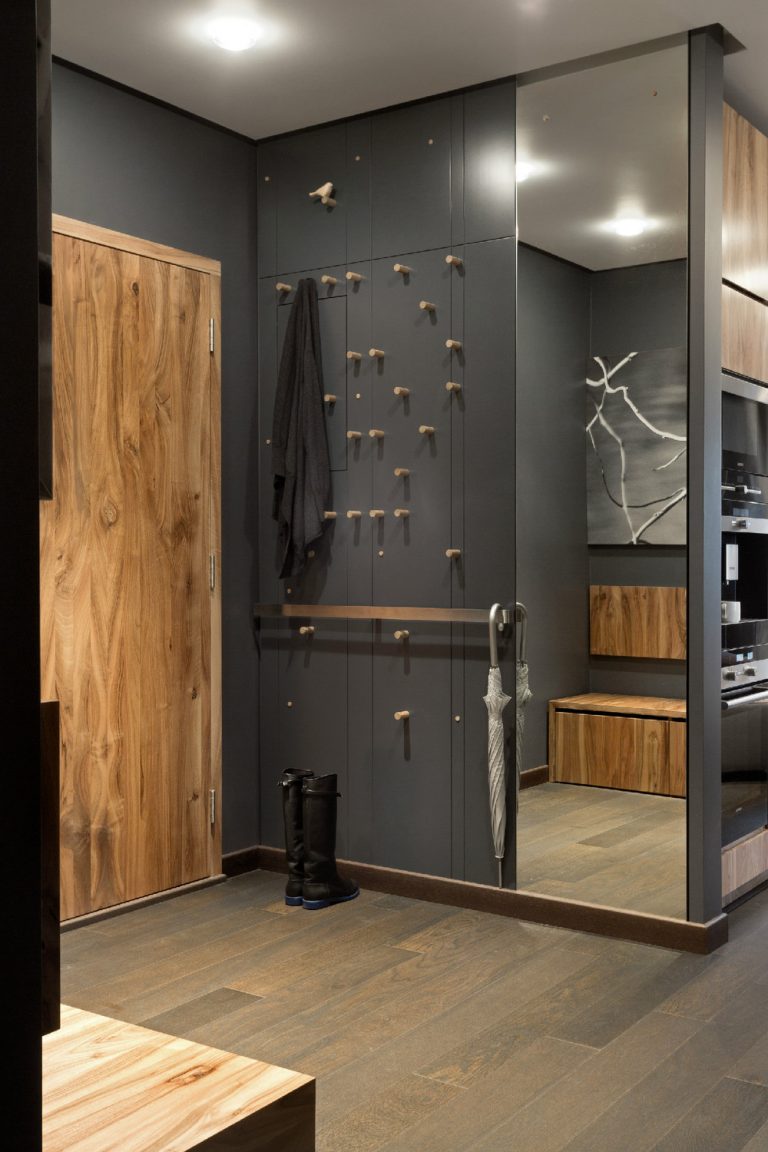
They will be resistant to high humidity, especially for flooring.
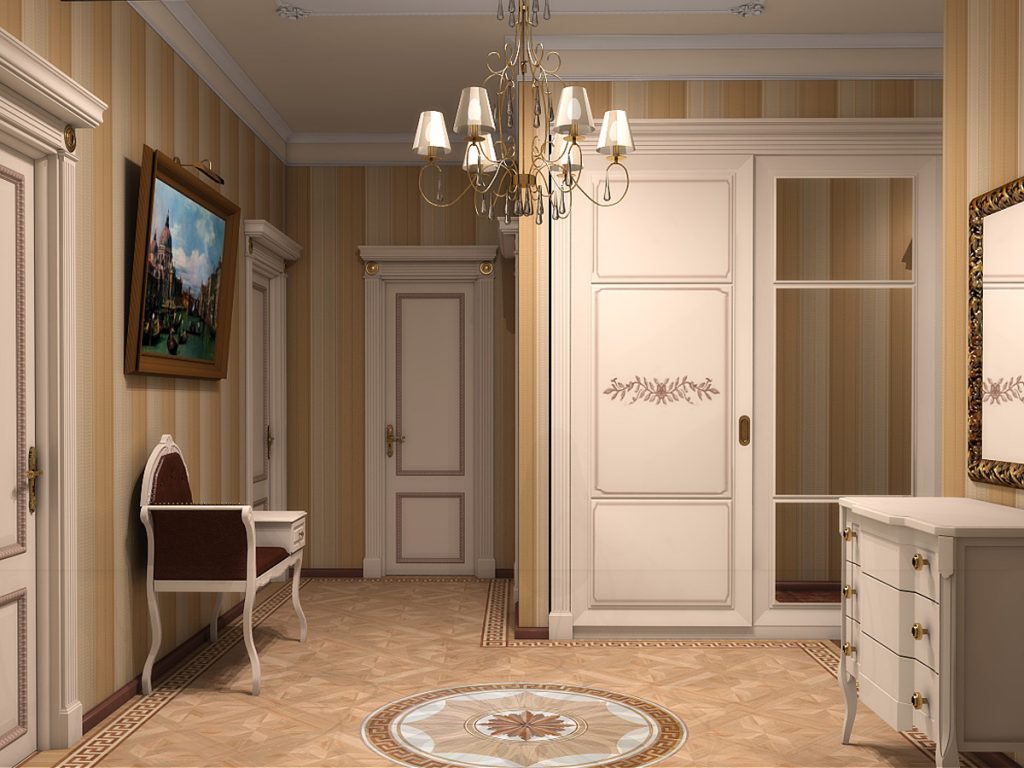
Easy care, where you need to clean as often and thoroughly as in the kitchen.
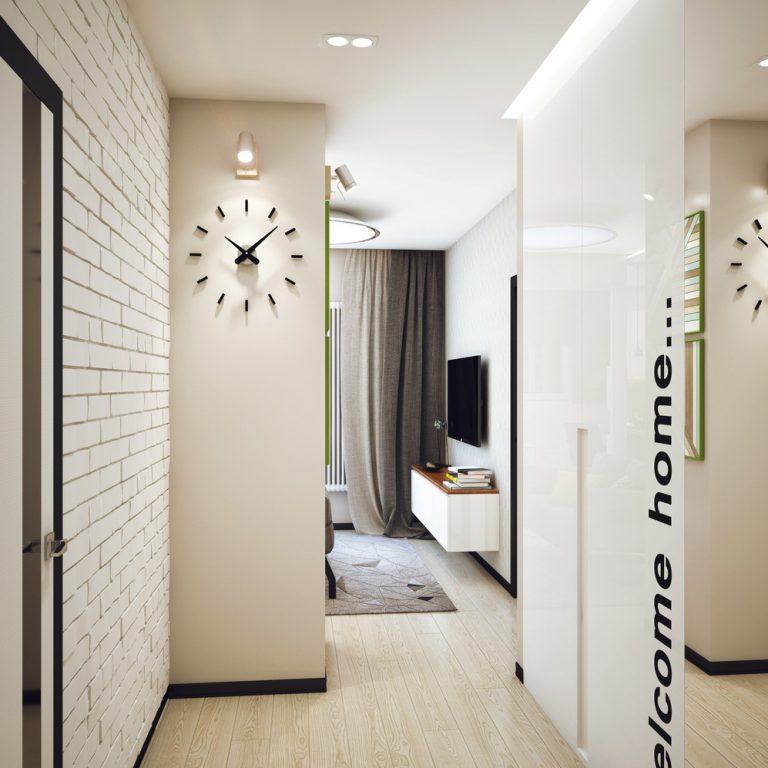
Floor coverings are resistant to mechanical damage, for example, to fallen heavy objects.
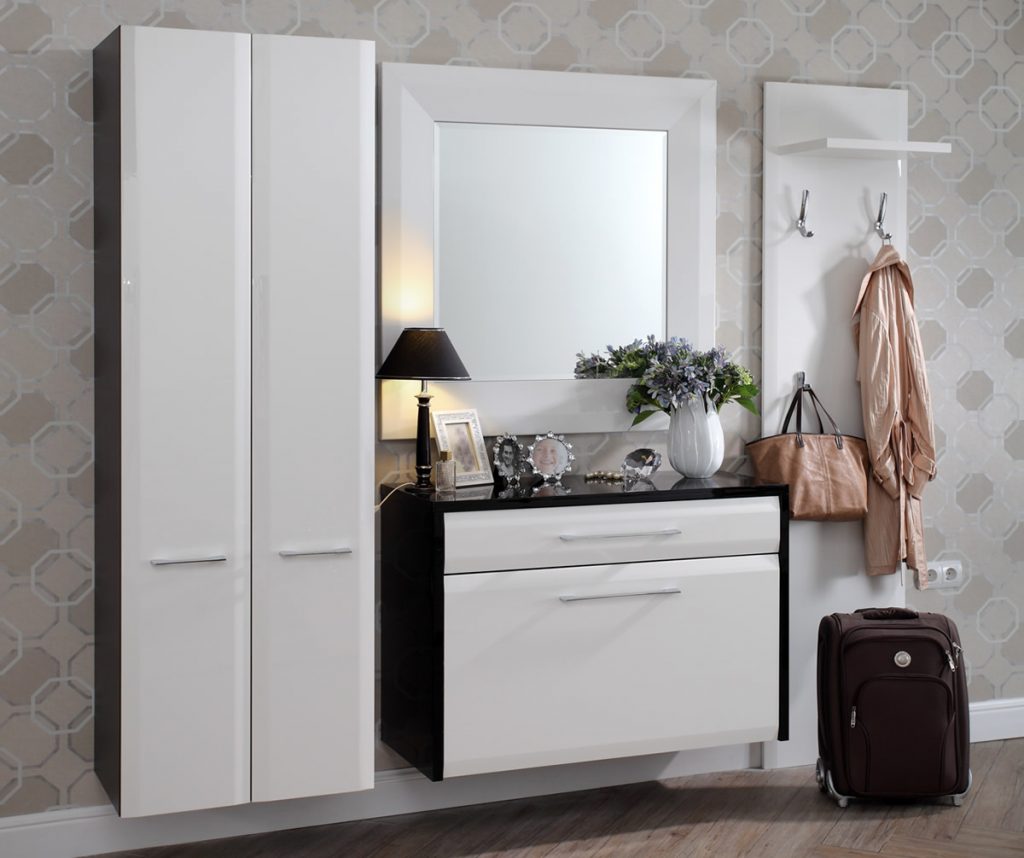
Here you should not apply too much wisdom by organizing complex structures. As a rule, the most popular ceiling design option here will be a smooth, light-colored surface.
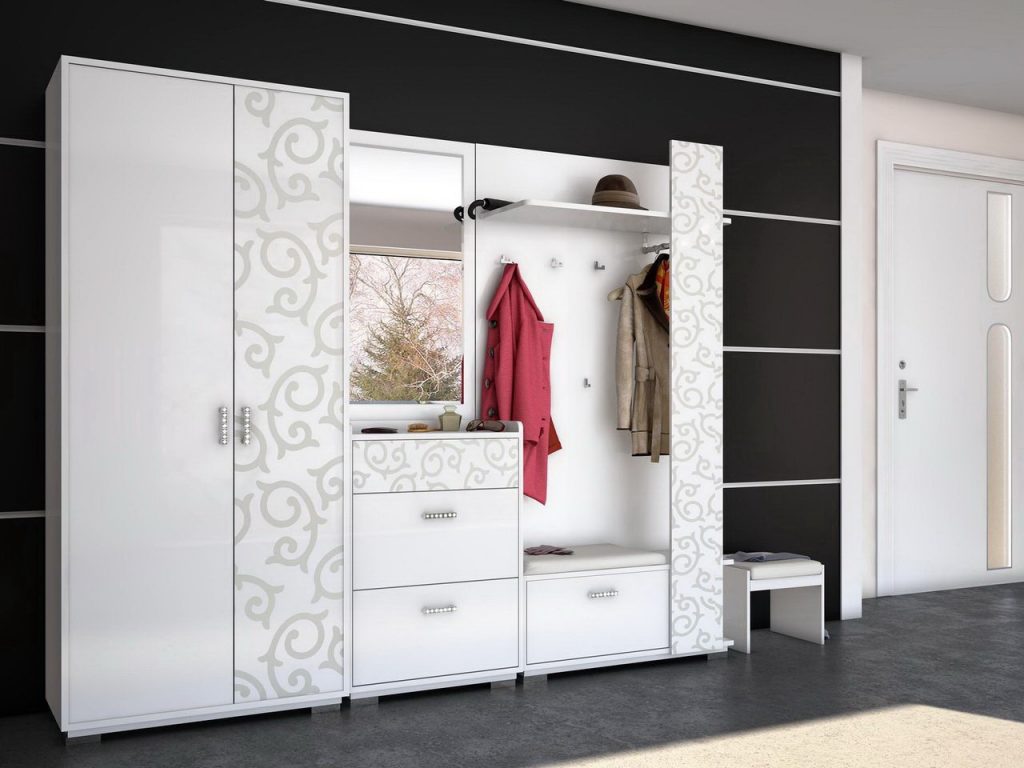
Using tension structures, the ceiling is made out as quickly as possible. The result is a completely flat surface. But, it will still have a drawback, it will not be possible to build in lamps, and you will have to equip only some hanging models of lighting fixtures.
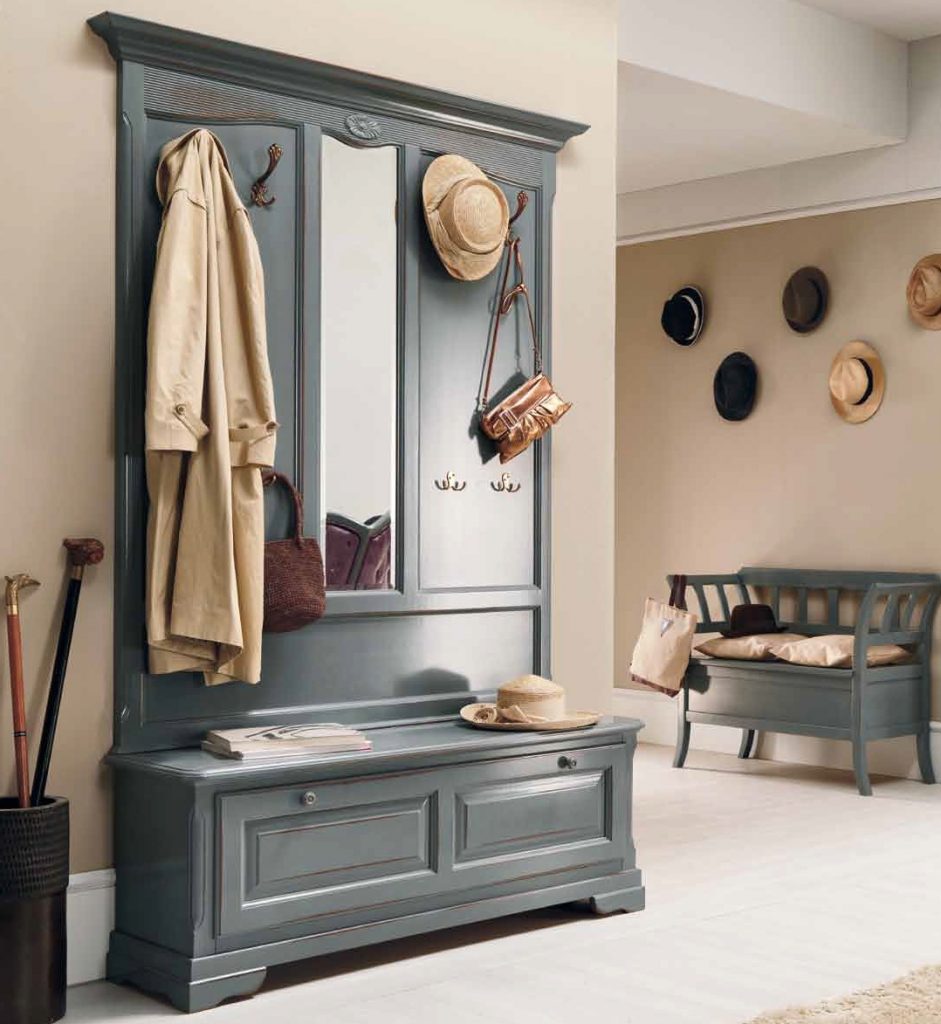
With suspended ceilings, you will have absolutely no restrictions in terms of choosing lighting devices.
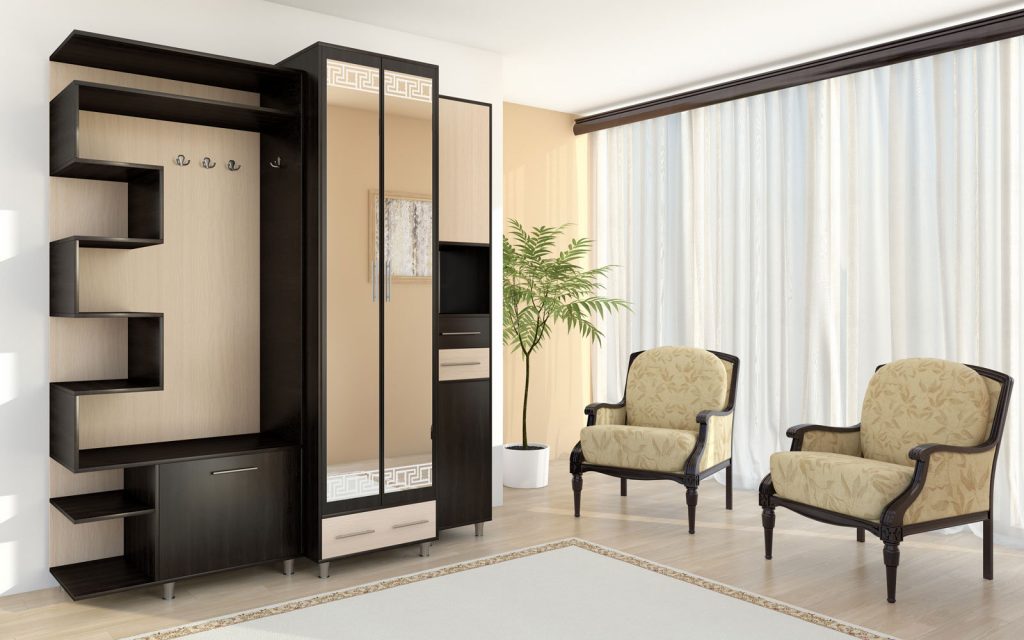
If the hallway smoothly continues another room, and it is not separated from it at all, it would be quite logical for the ceiling lighting to be the same - in each of the rooms in this case. The most successful option would be a perfectly even, snow-white ceiling. Thanks to him, the space will visually appear larger, while you will not have to face the problem of color combinations. You can see similar options for the photo design of the hallway presented in this article.
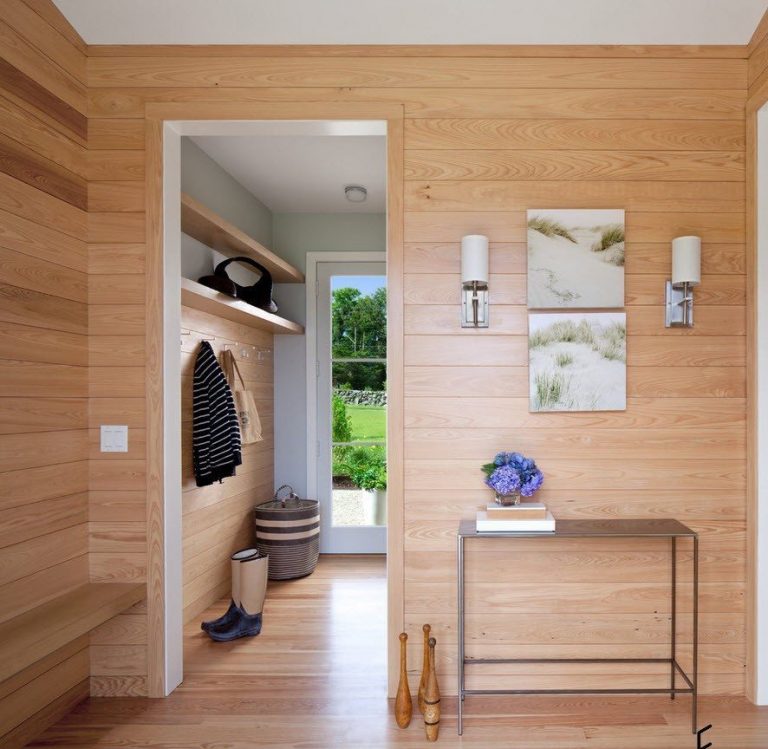
Also an excellent option for expanding the space is the use of a glossy stretch ceiling. Together with the sheen of gloss on the flooring, the room will look much larger than it really is.
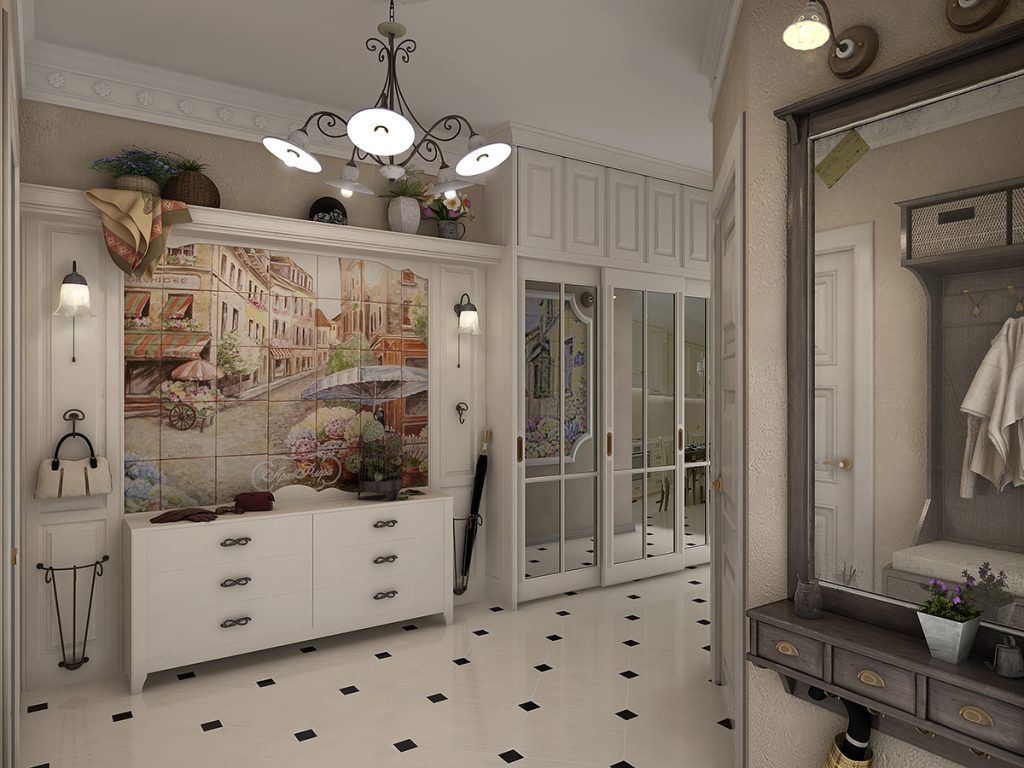
White color - ideal for wall decoration in the hallway, especially small dimensions. With finishes such as vinyl, liquid, paintable, water-based paint, panels of snow-white color, you will have practically no problems in terms of cleaning and maintaining cleanliness.
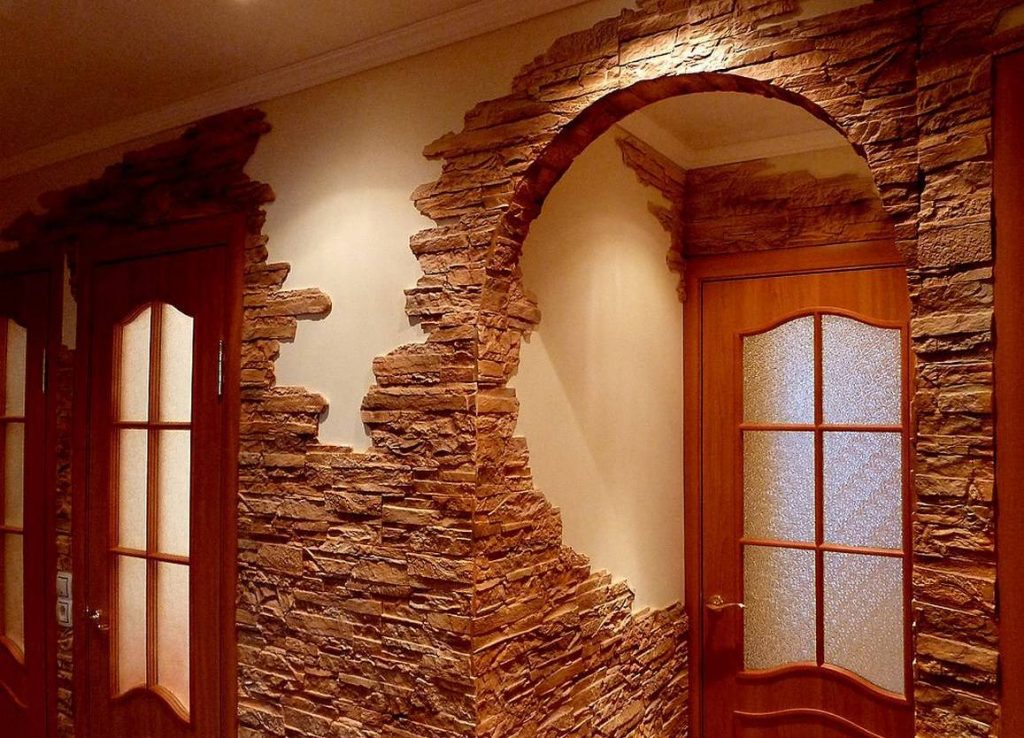
At the same time, light-colored walls will be just perfect to decorate it with some kind of wall decor, or choose bright furniture.
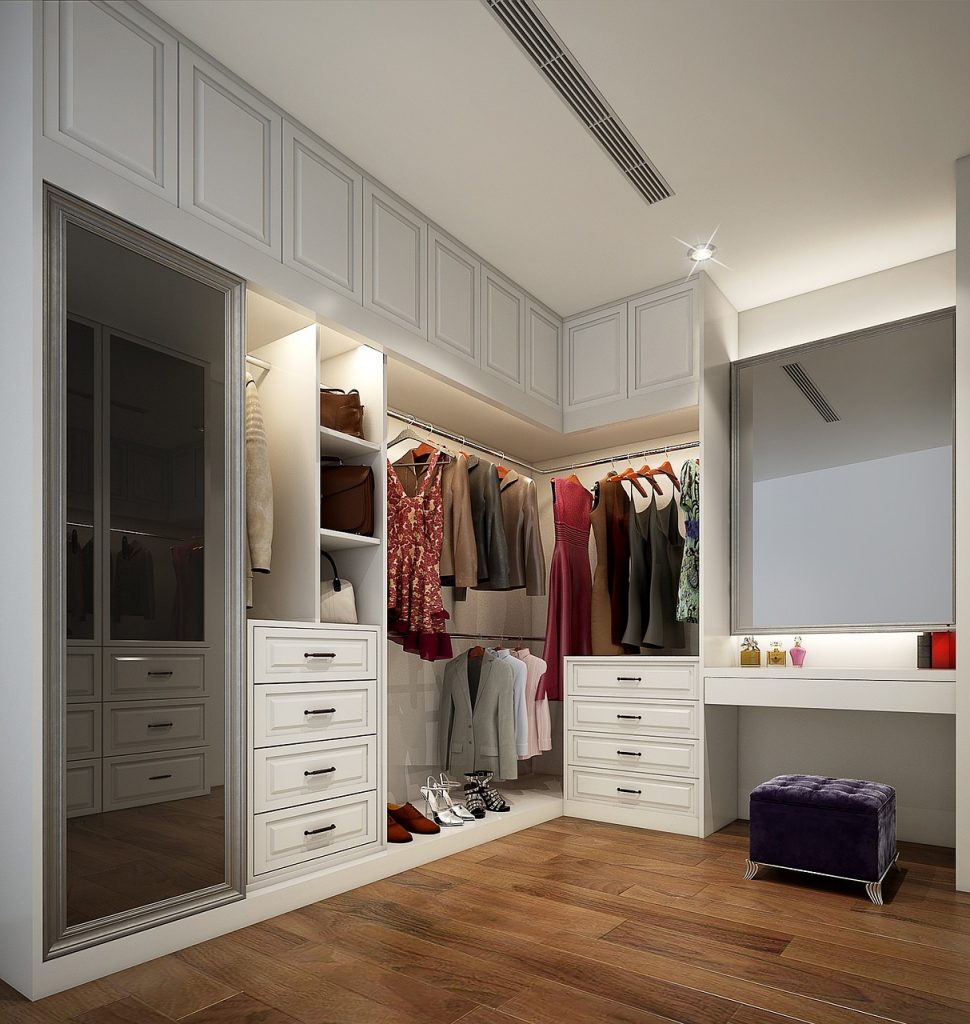
Here you can also use such a design technique as accentuating one of the walls. This will help wallpaper with a pattern, panels, photo printing, along with plain options for light surfaces. The brightness of the accent wall can also be supported by the same shades of lighting fixtures and other accessories in the hallway.
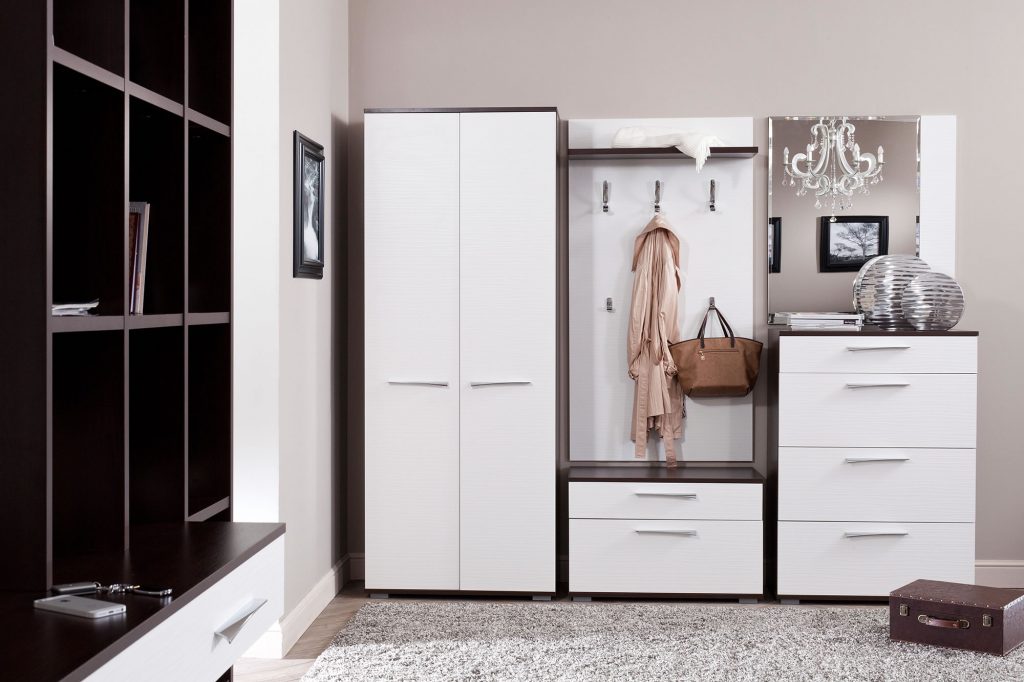
They can also be finished with wall panels. If you have a private house, materials with imitation of natural wood will look best here.
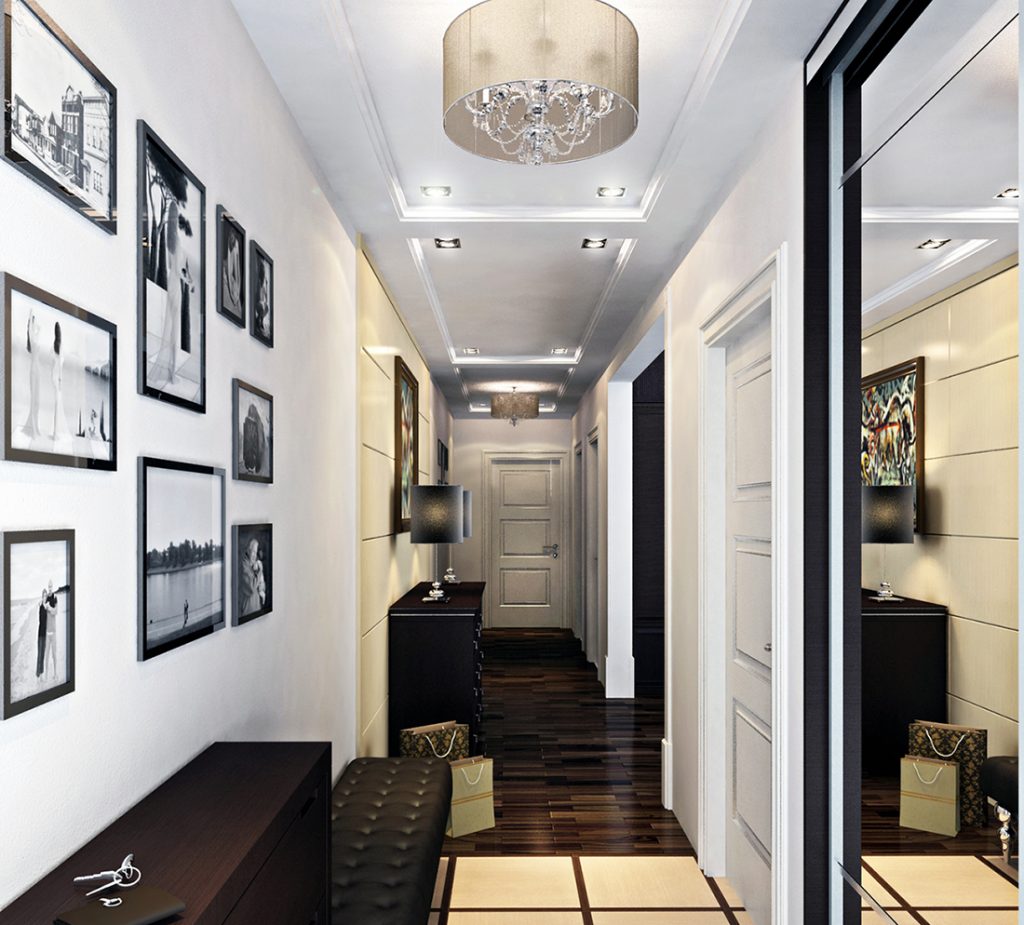
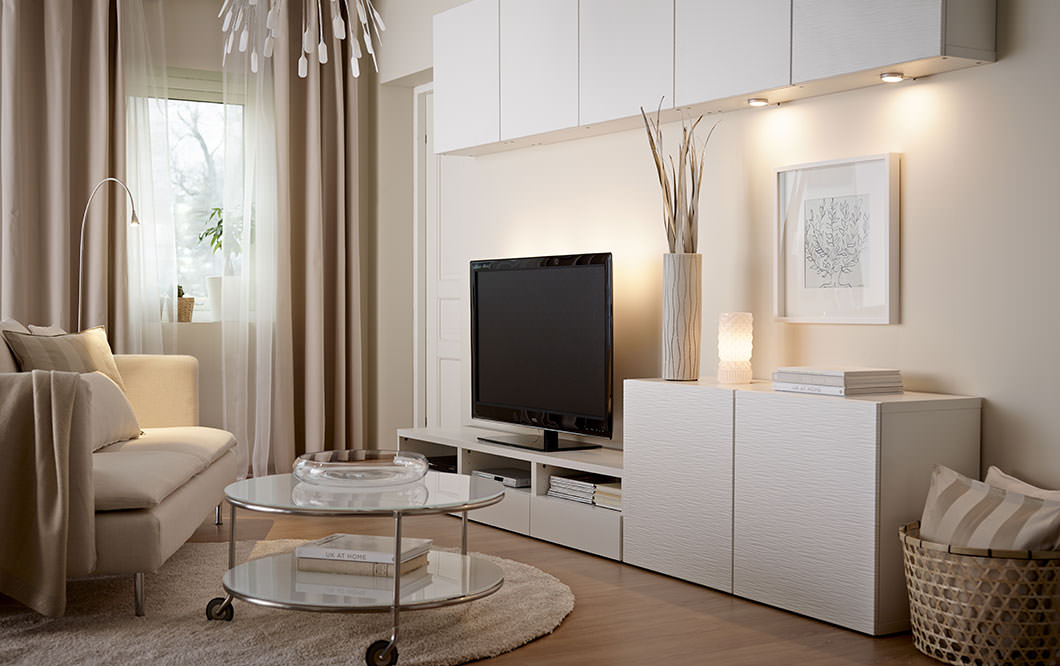
If you deviate from modern styles hallway design, they use concrete surfaces. Liquid or vinyl-based wallpapers, decorative plaster, metallized-based compositions perfectly help with this.
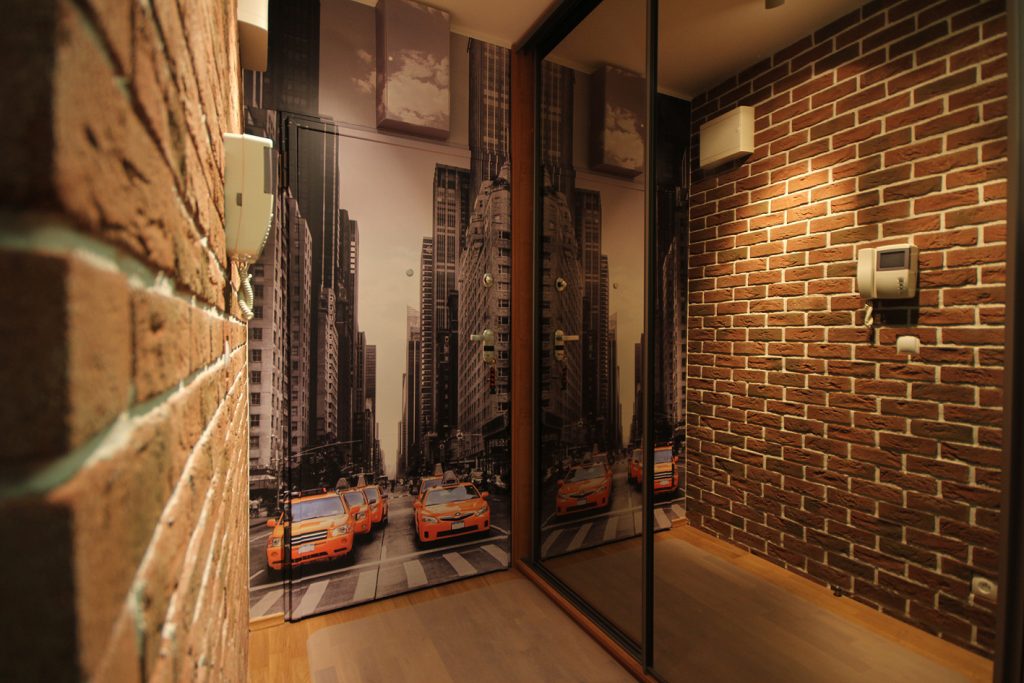
Stone or ceramic cladding is just perfect here, especially if we are talking about your own private home. These options are convenient, durable, reliable, give a special charm.
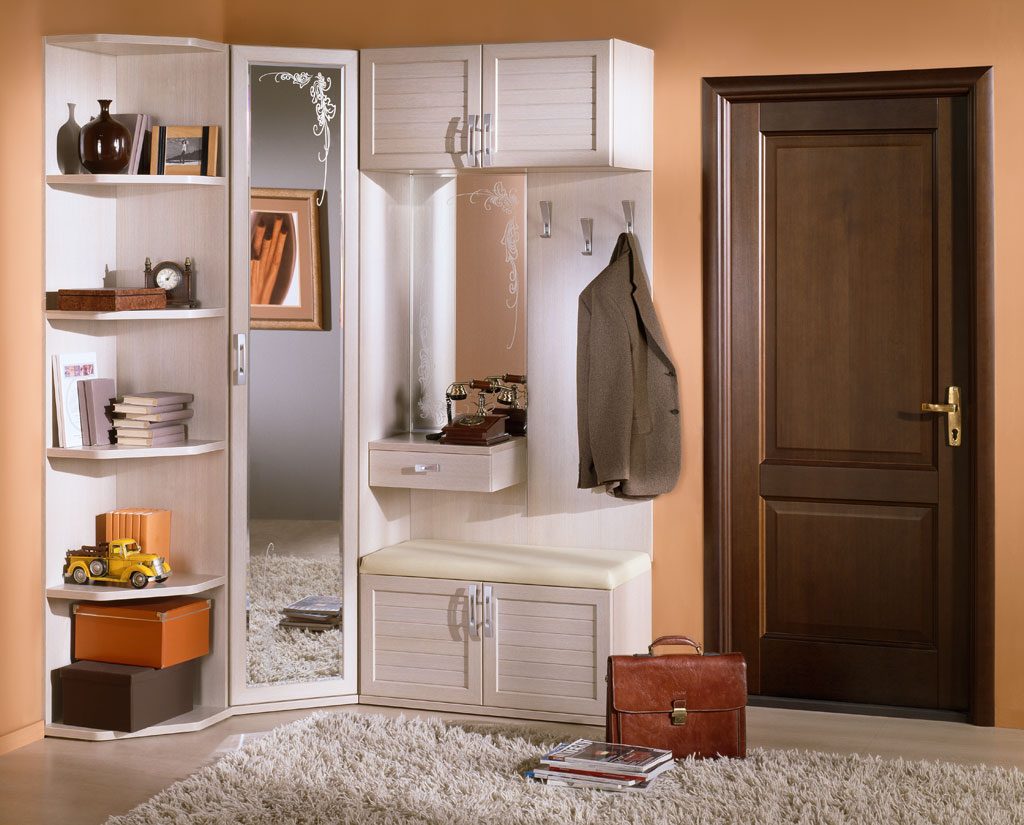
Figured variants of tiles in different colors can embellish the interior. Thanks to such a colorful coating, the hallway will look very original.

Laminate is also perfect here, but directly at the entrance to the house from the street on the floor there should be more moisture-resistant materials. For example, using floor tiles, a small area can be laid out with it near the front door.
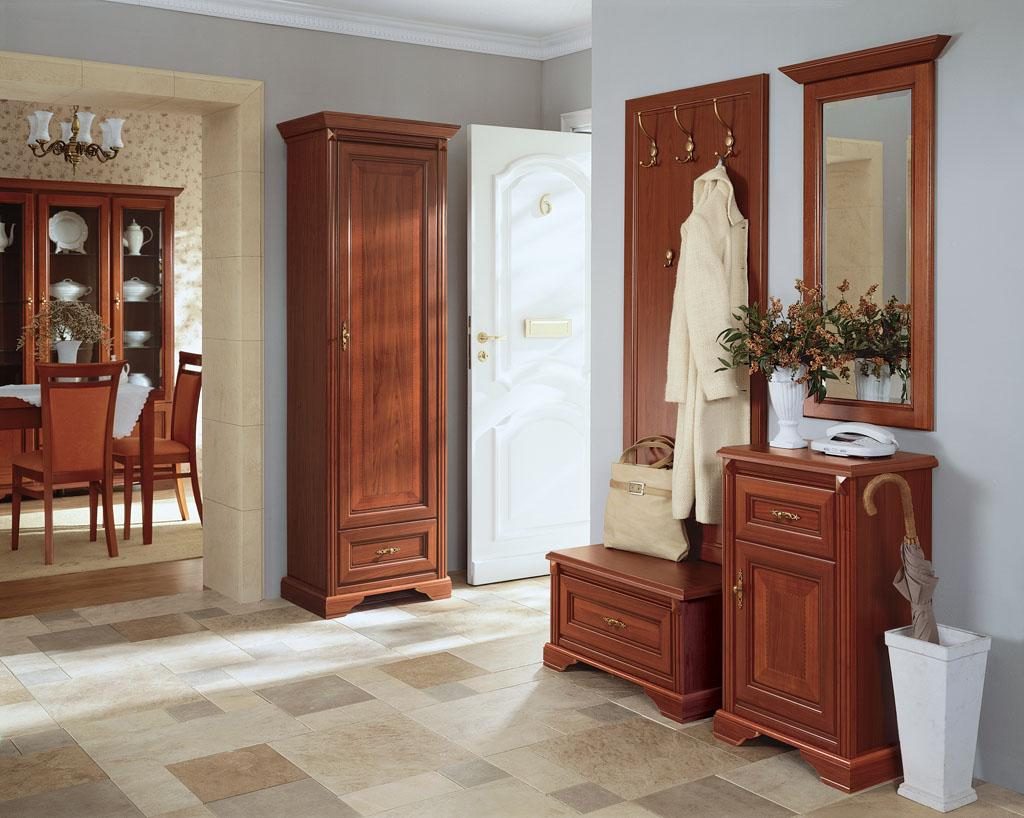
Parquet in the hallway will look chic and luxurious, but you should be as careful with it as with laminate, especially near the front door.
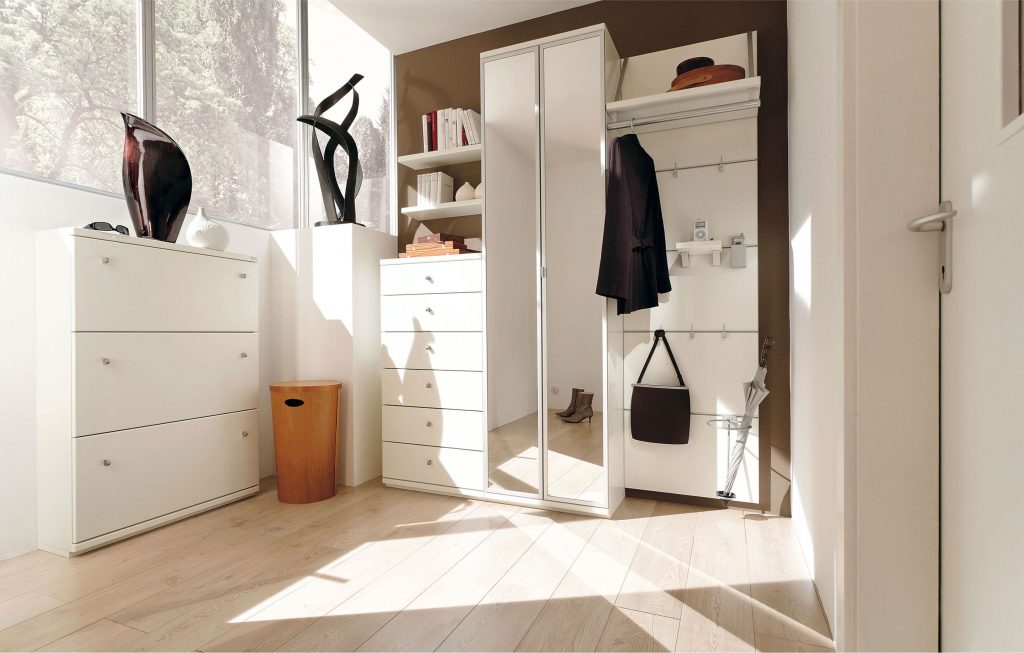
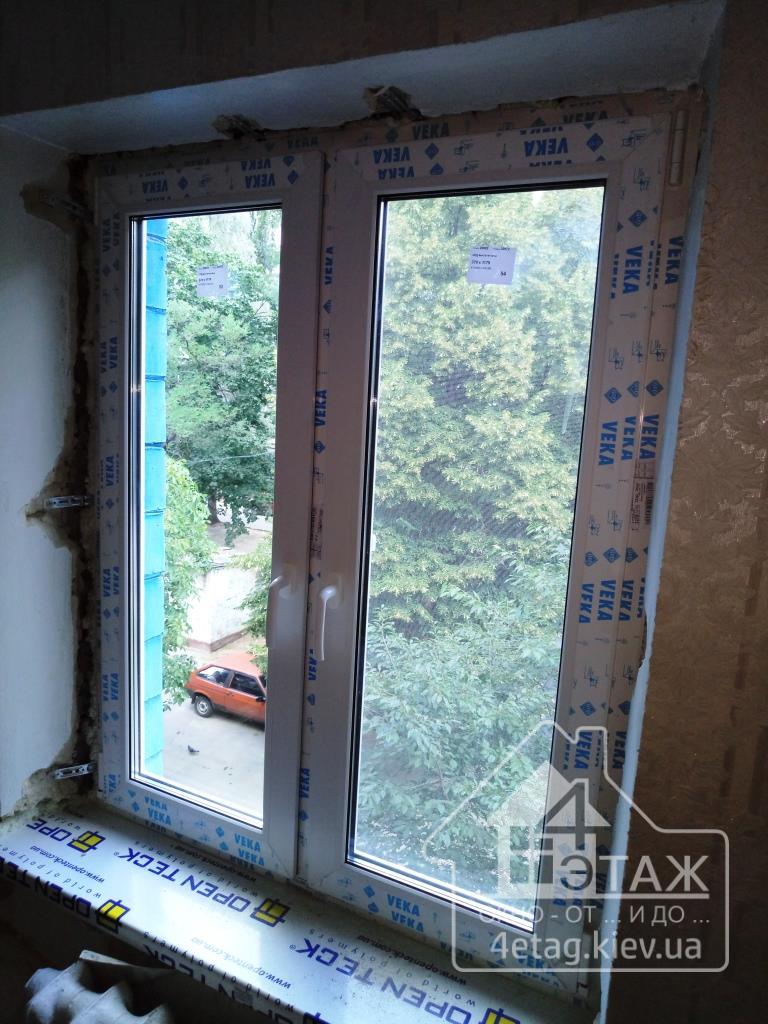
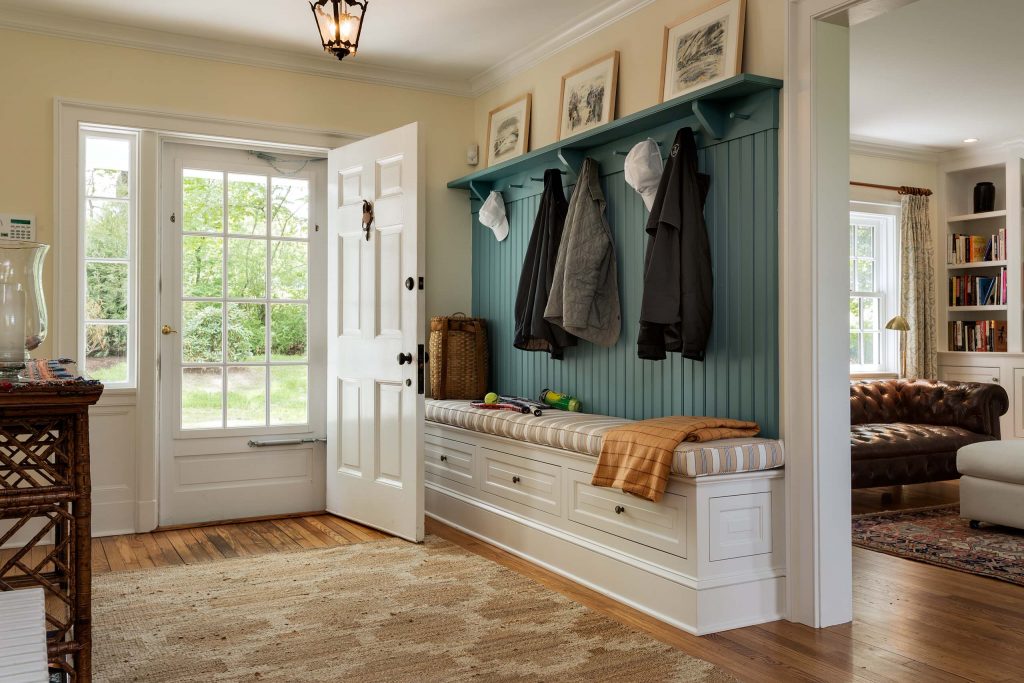
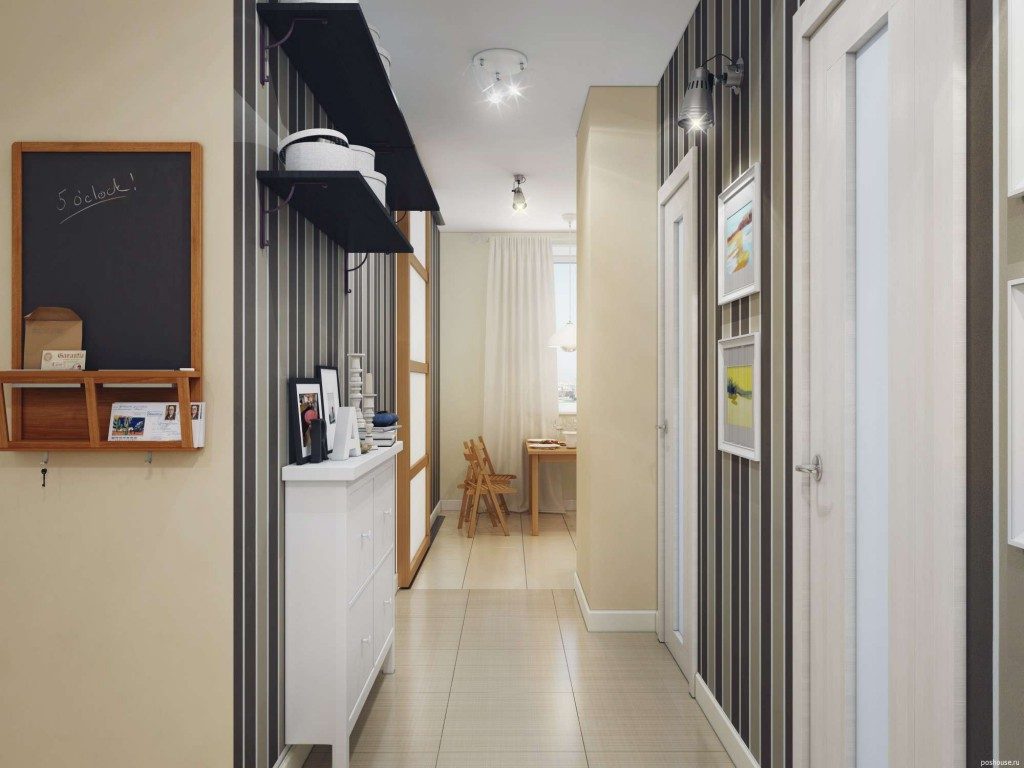

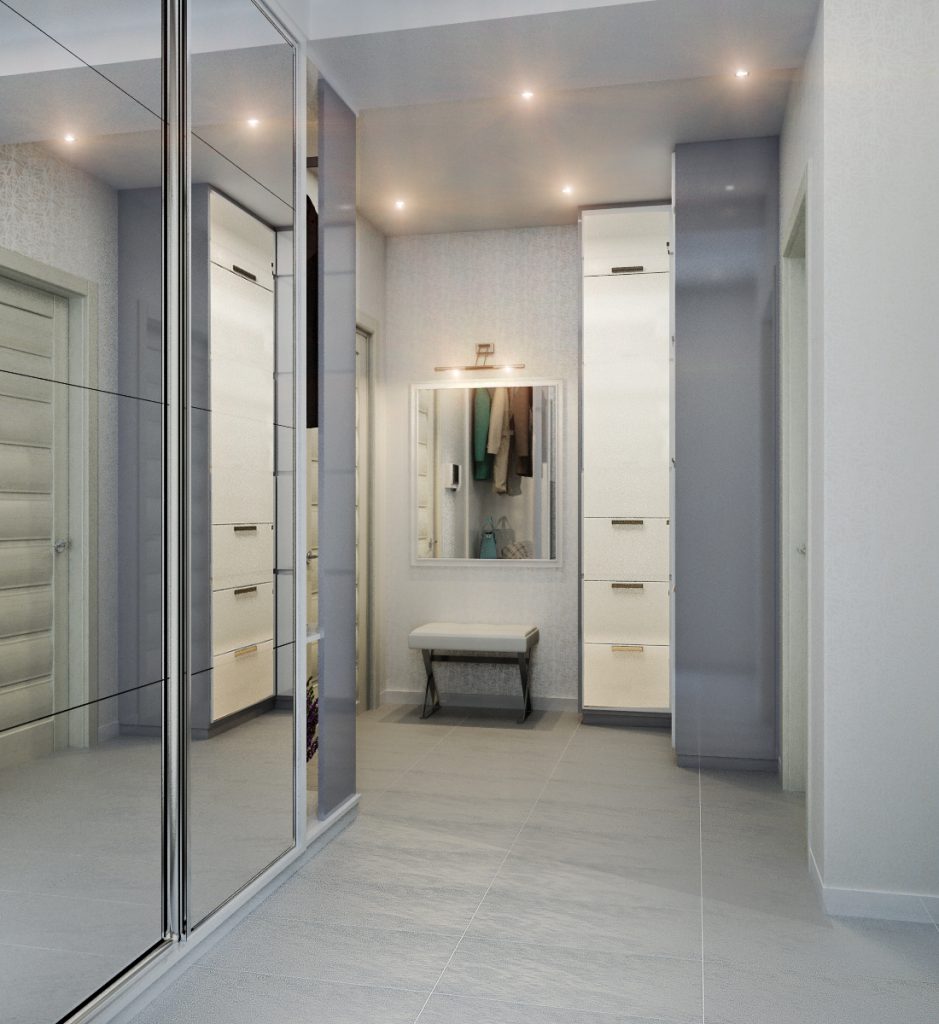
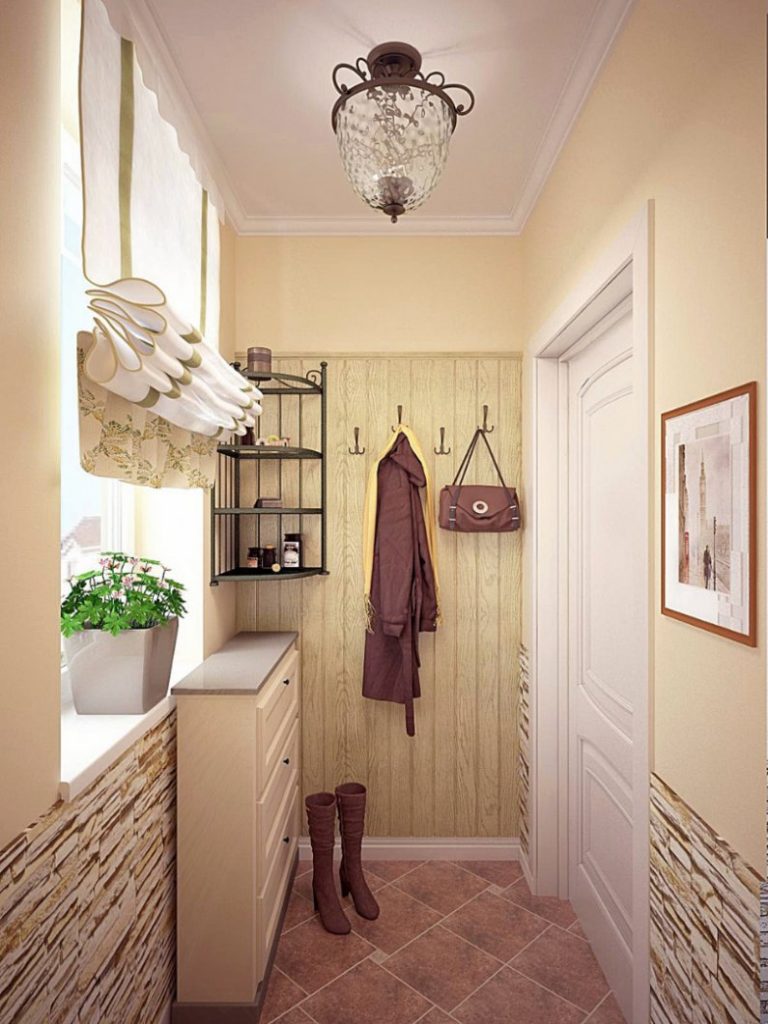
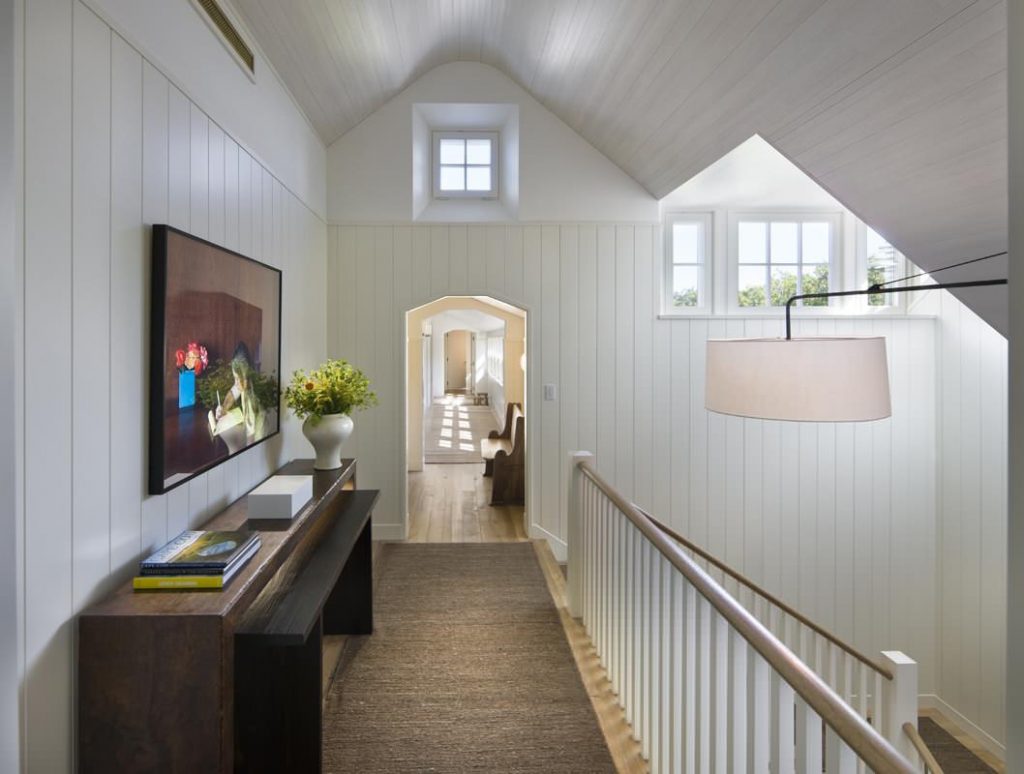
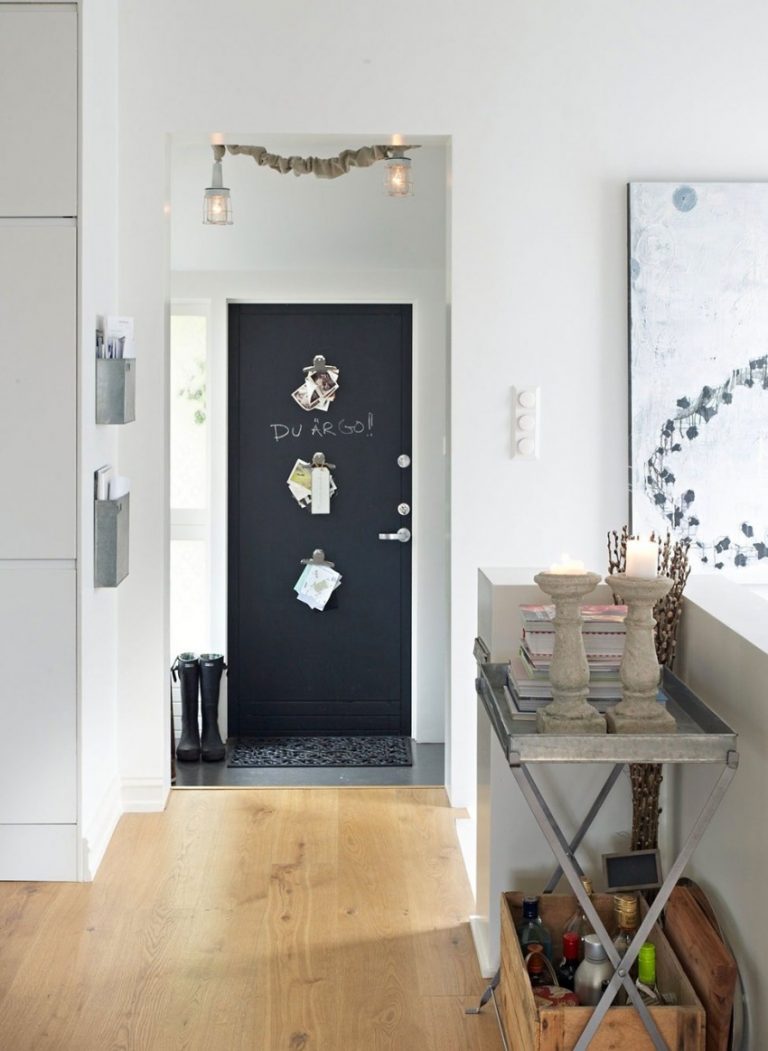

![]()
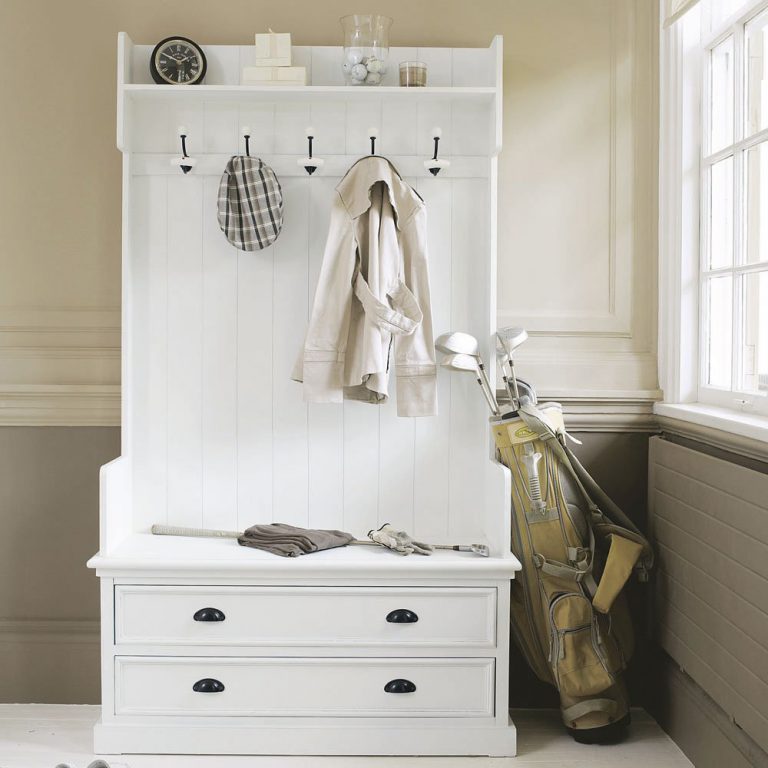
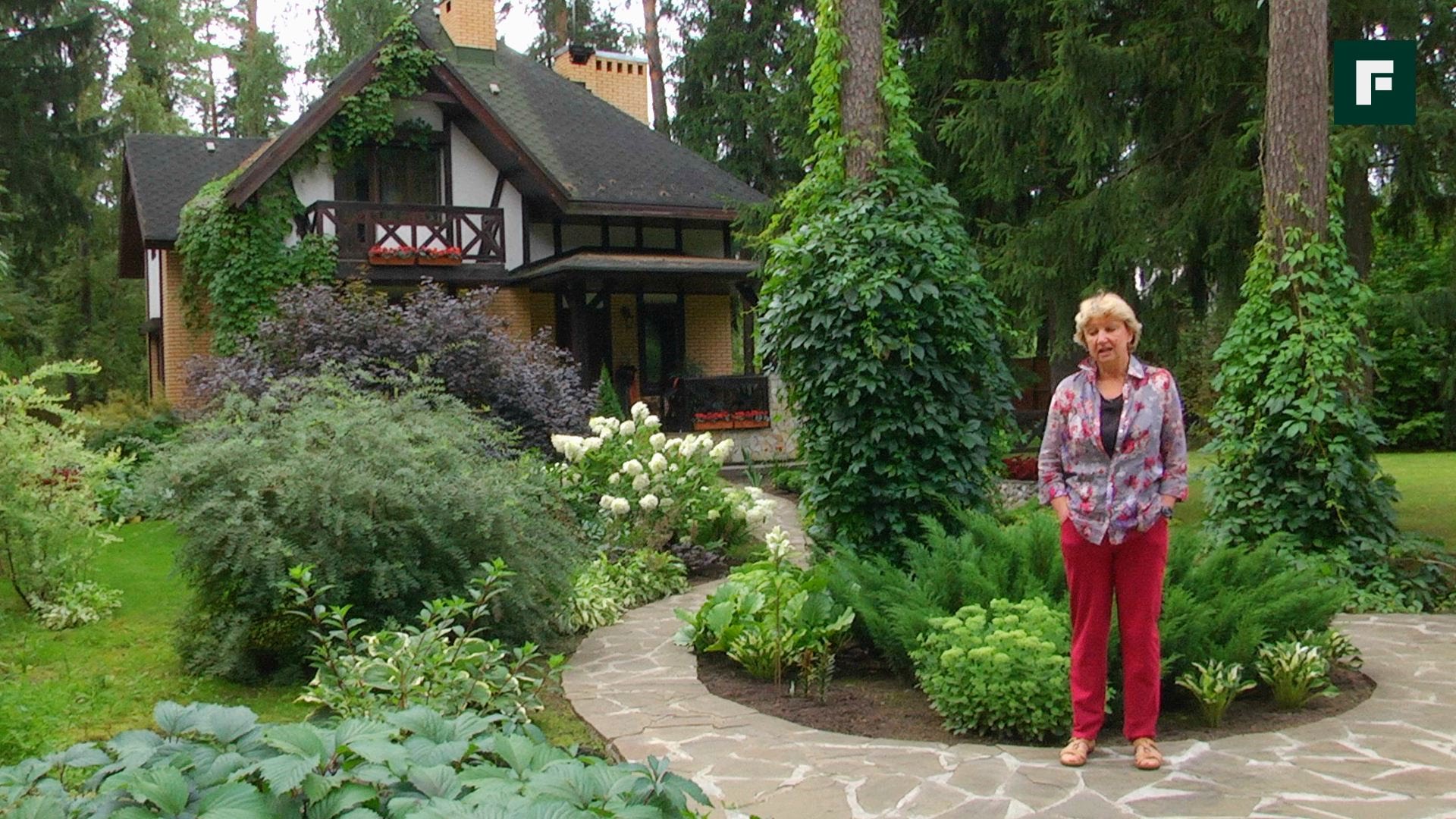
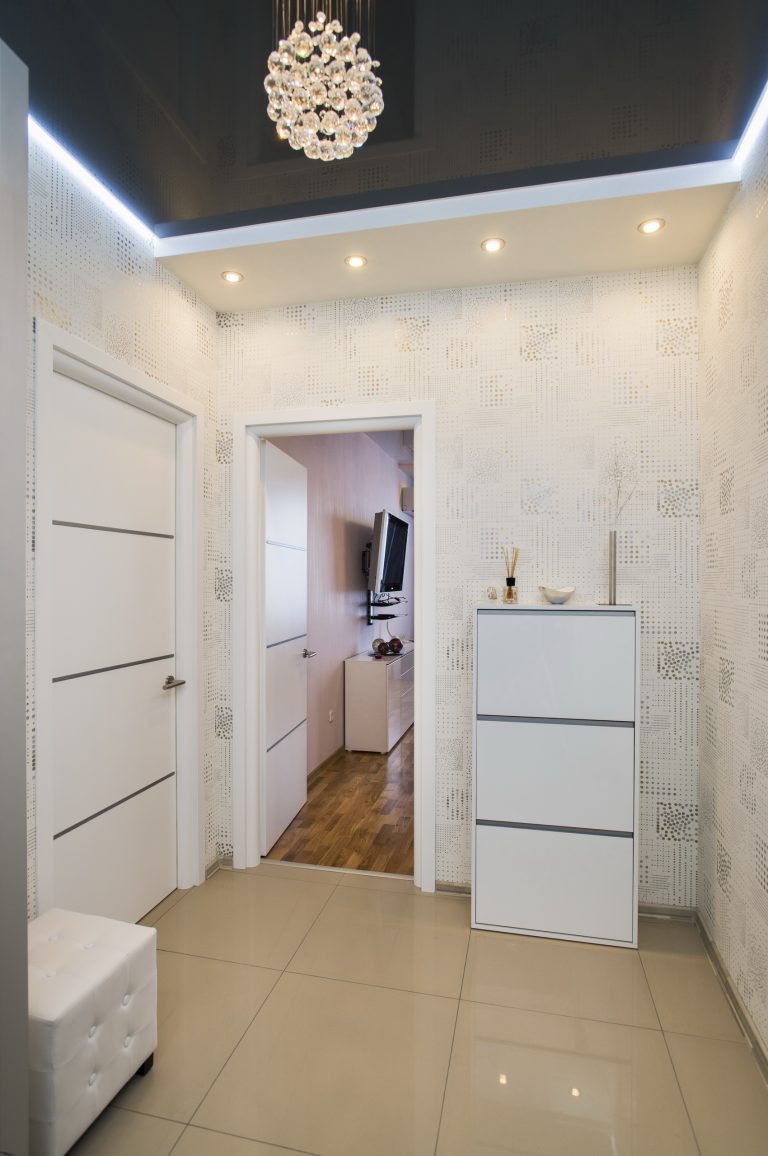
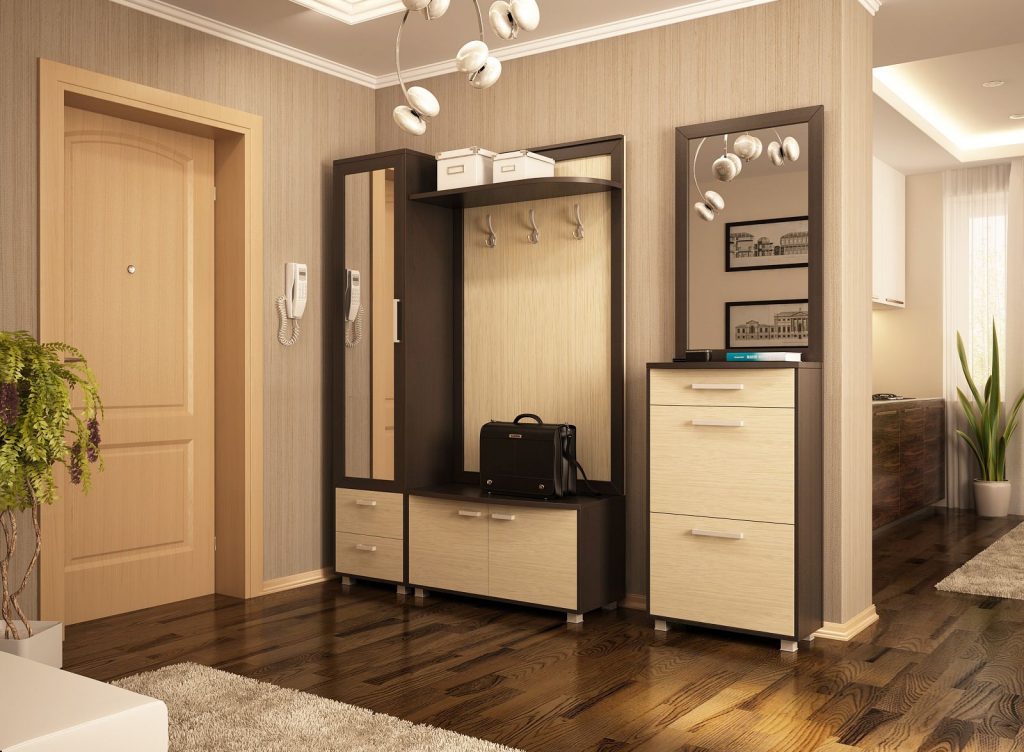


The corridor is the most visited room in the house, it is the first to meet guests. Beautiful decoration of the hallway affects the overall impression of the home. For a competent arrangement, you need to make the right layout, pick up interesting ideas for design, acquire high-quality and modern materials to make the interior pleasing to the eye of visitors.
They often put something in the corridor (bicycles, strollers), people walk around in outerwear and shoes. Cladding materials must be wear-resistant, durable, in harmony with the general mood of housing. Options for finishing the hallway in the apartment are varied. The choice of idea depends on the dimensions of the room, its illumination and the planned style of the interior. Proper selection of materials will help create a practical and presentable design that will create comfort and a positive attitude.
The corridor is the most accessible room in the house. Wall covering should be aesthetically pleasing, non-staining and easy to maintain. Ideas for decorating the walls in the hallway are replete with modern beautiful materials, their combinations. Many designers use the technique of finishing the plane up to half the height:
A long corridor can be zoned with pilasters from different types of masonry; this finish is also suitable for decorating corners and openings. Decorative plaster is a popular option. It is practical, goes well with stone inserts. The three-dimensional ornament, pigmentation, drawing on the surface looks beautiful. When decorating walls with tiles in the hallway, tiles with a spectacular texture are selected - under silk, metal, leather, wood, silver fabrics. For a minimalist setting, wall panels are suitable; with their help, a laconic interior is obtained.
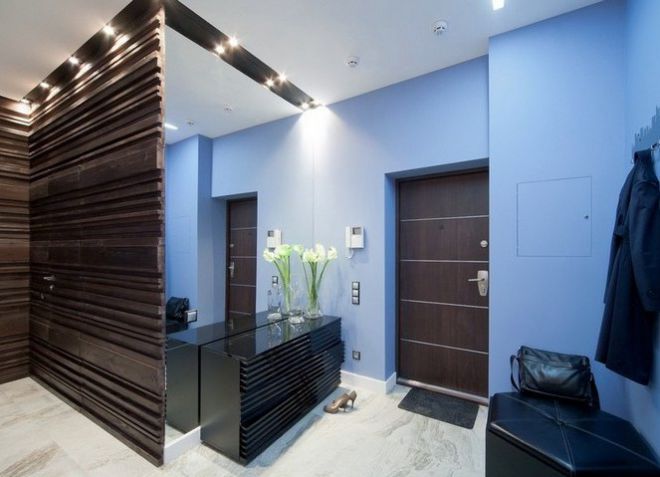
Finishing the hallway with cork is an innovative idea. The material is produced in many variations of textures and colors, which allows you to veneer surfaces, create panels on them, geometric patterns, horizontal stripes separated by shiny overlays. hallway decoration PVC panels affordable, provides ample opportunities in interior planning. They are produced in a wide variety of colors, patterns, with imitation of natural textures - wood, stone, sand.
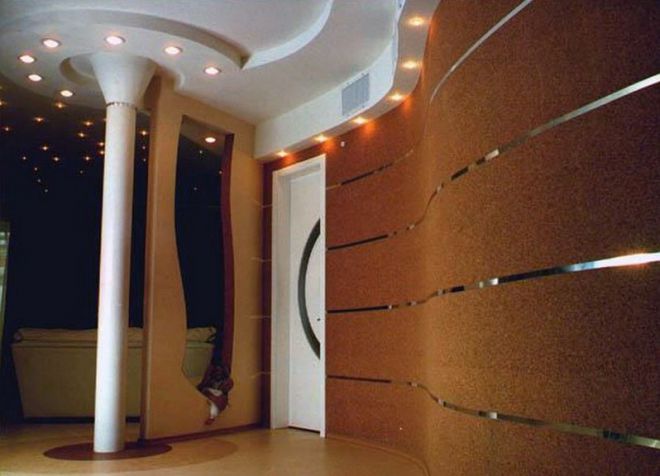
All design elements should create a single complete picture. Competent ceiling decoration of the hallway in a private house allows you to choose stylish lighting for the room, create a comfortable atmosphere in the room, and visually enlarge it. Painting is a budgetary way of finishing, with its help a conservative design is created, you can decorate the ceiling with curly cornices.
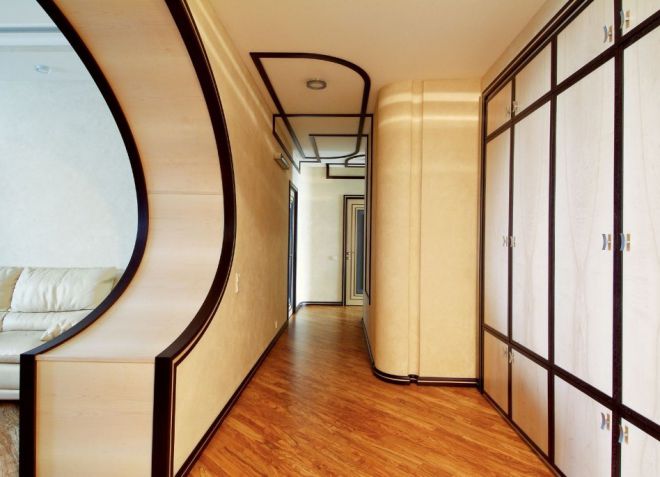
Mirror plates are an extravagant way to finish the hallway, with their help it is easy to enhance the illumination of the room. Decorative plaster will help to arrange a fashionable relief on the ceiling. Suspended drywall structures are a popular option, with their help you can create geometric, curvilinear shapes, mount beautiful hidden lighting. The frame can be combined with stretch fabrics that allow you to design a ceiling of any shape.

The corridor often has a non-standard layout. Finishing the hallway in the apartment is accompanied by the protection of corners, especially external ones from various mechanical damage. They often suffer when moving furniture, household appliances. For finishing convex surfaces, wooden, plastic corners, the color of which is selected to match the doors or as a contrast to the wall decoration. Facing these parts of the room with artificial decorative stone is popular. This option makes the room more expressive and rich.
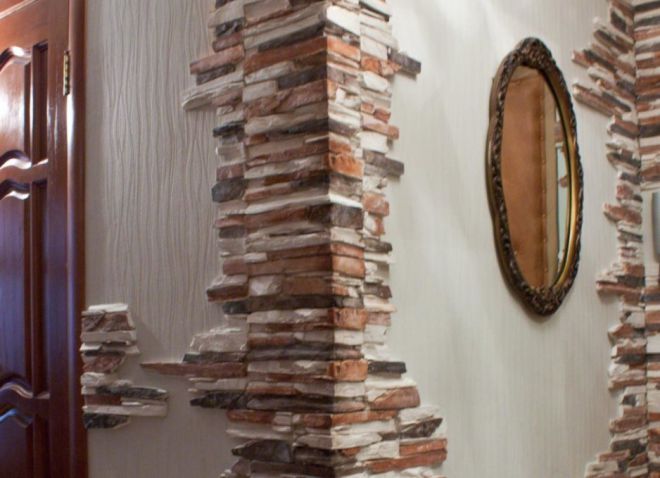
The best choice for the corridor are materials with increased strength characteristics. Among the common types of floor coverings, there are budget and elite options - from linoleum to natural stone. Finishing the hallway with tiles is especially relevant due to the high traffic of the room, the ingress of moisture and dirt from the street onto the floor. When choosing color options, dark-colored tiles with a rough non-slip surface are preferred. With the help of tiles of different shades and sizes, it is easy to lay out beautiful patterns on the floor.
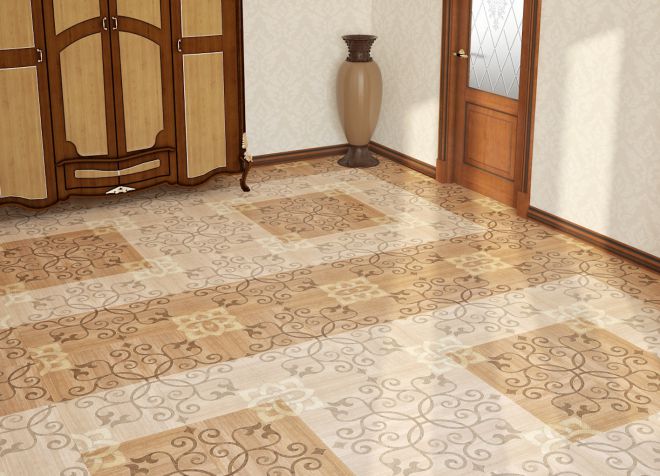
Porcelain stoneware is a durable texture, it is a natural stone made artificially, it looks elegant and solemn. High density laminate is also suitable for finishing the hallway. With the help of planks, a surface of different shades is laid out - from gray to the color of dark wood. From parquet blocks, standard Christmas tree and square ornaments are made, an artistic drawing is drawn up, and the dies are varnished on top. When using wood for floors, it is better to use a more moisture-resistant material in the entrance area, such as tile.
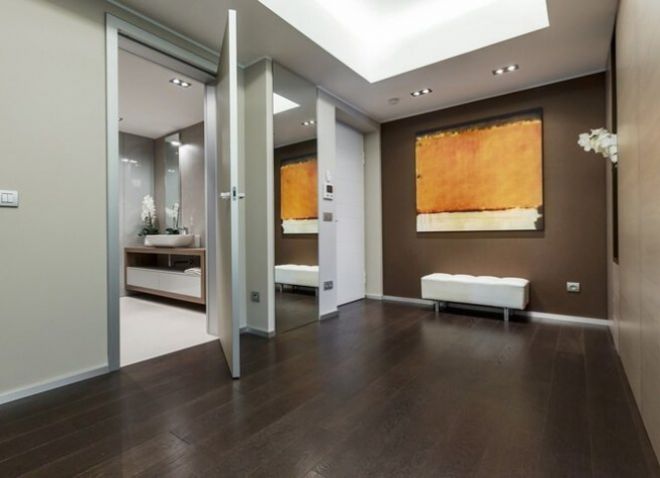
A corridor is a passage that connects rooms in a house. To expand the space in it or zoning a narrow layout, they are drawn up. They are an important decorative element of the interior. Such an opening can be trimmed with polyurethane stucco, painted in any color. The arch, decorated with glued wooden blocks, contrasts with the surface of the walls and looks elegant. Decorating the hallway with wild stone is very popular. With this design, openings, corners, some sections of the walls are decorated with masonry. In this case, an attractive textured relief is obtained.
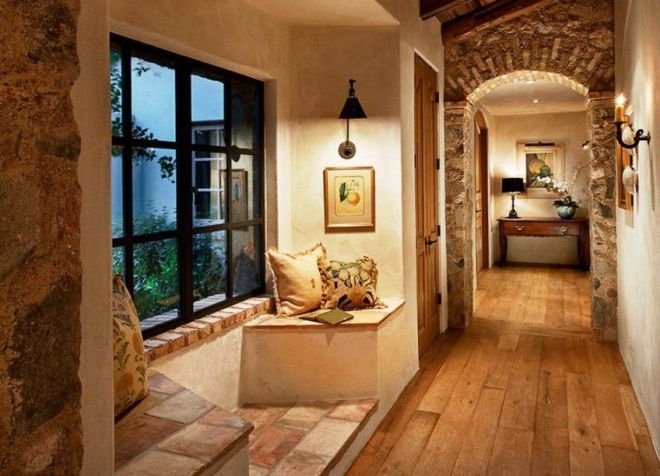
The corridor belongs to the auxiliary premises. The material for finishing the walls in the hallway must be wear-resistant, since such a room has the maximum load. Surfaces are selected non-staining and easy to clean. Wall cladding should be combined with ceiling and flooring together to create a harmonious interior. Manufacturers offer a wide range of materials - from the latest developments to traditional, with improved performance and design.
Competent selection and combination of cladding options allow you to create an unusual design. Decorating the hallway with artificial stone is a popular and attractive technique. They completely lay out the wall, its bottom, some part, combine masonry with a plastered or otherwise designed surface. Doorways and corners are laid out with stone, which contributes to decorative design and protection of vulnerabilities from damage. It accurately imitates the natural analogue of limestone, pebbles, marble, sandstone, slate.
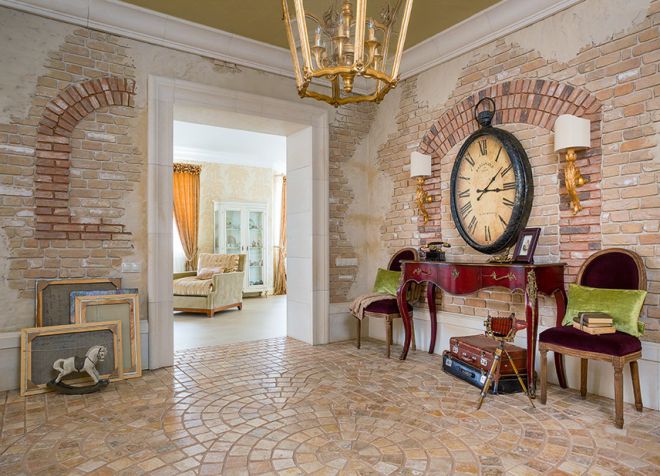
With this traditional cladding method, you can create a beautiful interior. Decorating the hallway with inexpensive wallpaper with a contrasting pattern will make the interior more comfortable. Striped canvases will help visually adjust the height and length of the room. Modern wallpapers are of very different quality. There are canvases similar to silk, velvet, embossed, embossed. There are options with a stone or bamboo veneer applied to the surface.

Finishing the hallway with liquid wallpaper allows you to combine the practicality of the coating with its beauty. They do not have joints, do not move away from the walls, are easily restored, do not attract dust. On such a surface, a drawing, an ornament is easily applied, you can draw a real picture. Wallpaper is a common material that can aesthetically and inexpensively decorate a room.
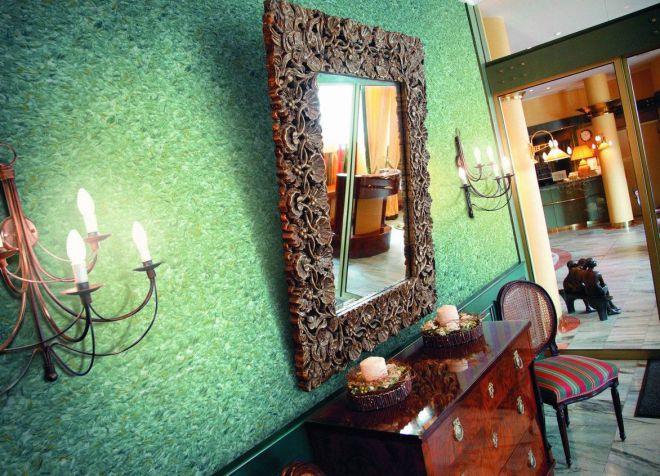
For the design of the corridor, many prestigious options are offered. Finishing the hallway with MDF panels attracts with the environmental friendliness of the material, ease of maintenance and ease of installation. The outer side of the slats is decorated with a coating that imitates wood of different species (ash, oak, mahogany) or other natural materials - leather, marble, even silk.
Some panels are laminated (covered with a protective film), due to this they acquire a smooth glossy surface. There are planks with original patterns, reliefs, 3D effect. The drawing on the boards is sometimes processed with silver or golden paints, creating the effect of antiquity. The panels can be installed to the full height of the walls or occupy their lower part, combined with other materials.
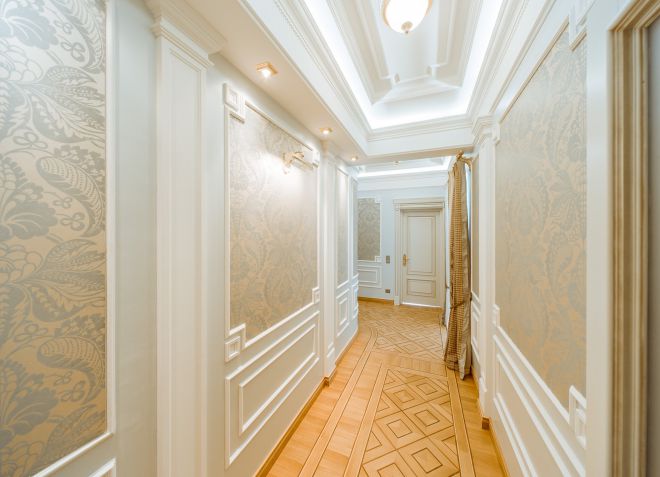
Wood has not gone out of fashion for centuries due to the amazing properties that create a favorable microclimate in the apartment. There are several finishing options. The most expensive method is to use wall panels. Often they have a beautiful geometric relief, shades of natural wood of different species or a painted version of the material are used. For example, the decoration of the hallway in Khrushchev can be done with light panels in the Provence style. They are creamy, pale blue, worn. Such a room will look airy and elegant.
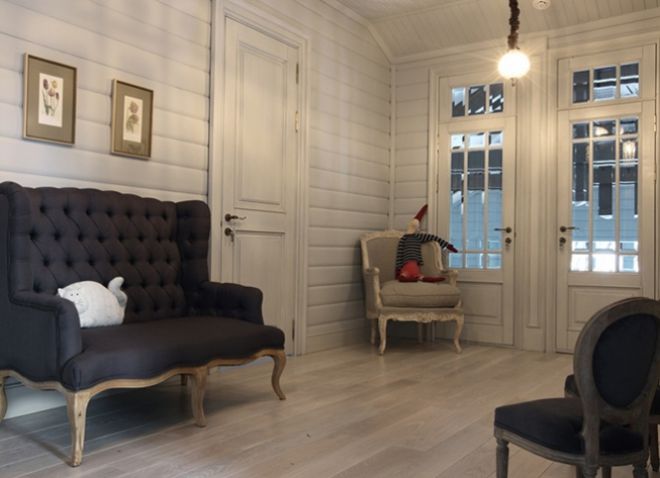
Finishing the hallway with clapboard is the ability to use natural, environmentally friendly, affordable material. Sheathed walls are warm to the touch, retaining the texture of wood. The material is a narrow slats, due to their vertical or horizontal arrangement, you can create the effect of lengthening or expanding the room.
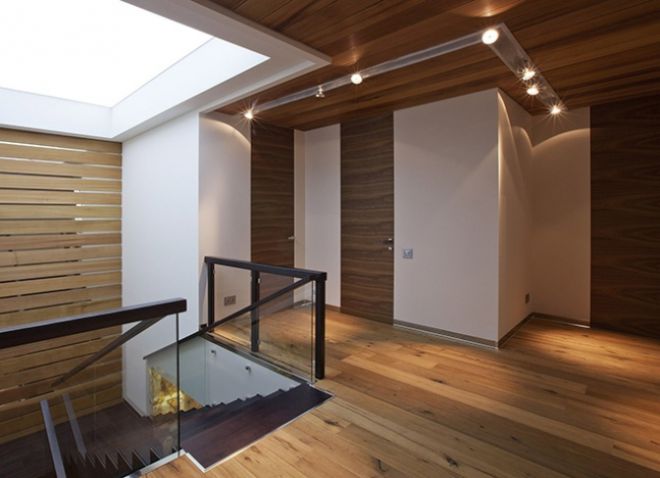
Stone cladding guarantees solid masonry solidity and external attractiveness of the walls. Interior tiles imitating different types brick, attracts with durability and aesthetic appearance. It has a small thickness and allows cladding without loss of usable space, which is important for the corridor.
Finishing the hallway with bricks can be done with materials of different shades, sizes, textures. Red masonry looks industrial, white masonry looks elegant, visually enlarges the room. You can pick up an aged brick with bumps and scuffs. It is necessary to use masonry on the walls in reasonable quantities (especially dark), combine it with other materials.
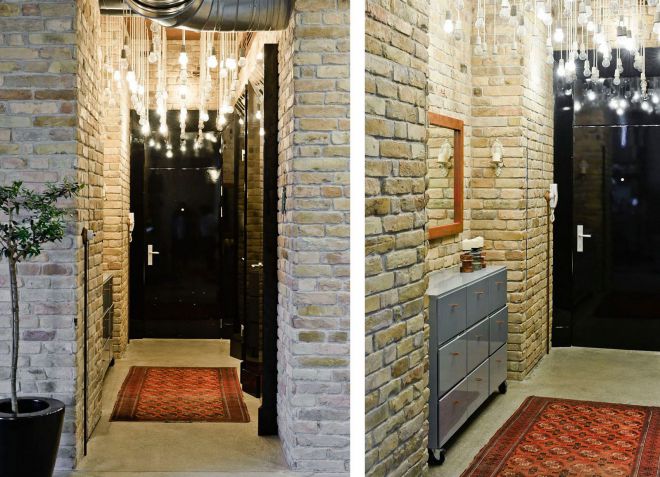
For the design of the corridor, available material is relevant, easy to install and maintain. Finishing the walls with laminate in the hallway does not require preliminary leveling of the surfaces, it allows you to hide all the defects. You can easily choose a material that imitates any type of wood and various natural surfaces. It is durable for the corridor. Finishing the hallway with laminate allows you to make panels to the height of the board or decorate one of the walls, for example, the one to which the furniture adjoins. Such material looks modern and concise.
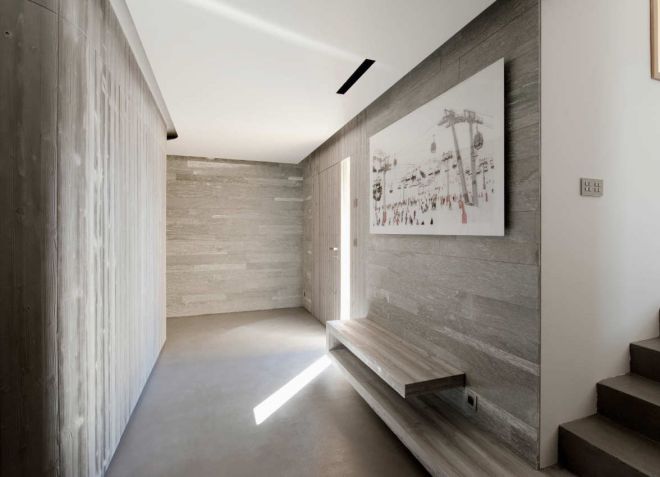
When repairing the corridor, an option is selected that is beautiful in design, practical and functional in operation. Types of wall decoration in the hallway are striking in variety, decorative plaster helps to quickly carry out repairs and equip the room of your dreams. Mixtures imitating natural stone, wood, sand are popular. It looks interesting plaster under the fabric or skin of reptiles.
The use of wax, gold, silver paint allows you to achieve an additional decorative effect of the finished surface. It looks luxurious with a marble deep effect, structural mixtures make it possible to create embossed surfaces due to interspersed with mineral particles. By using different formulations on the walls you can even make voluminous panels.
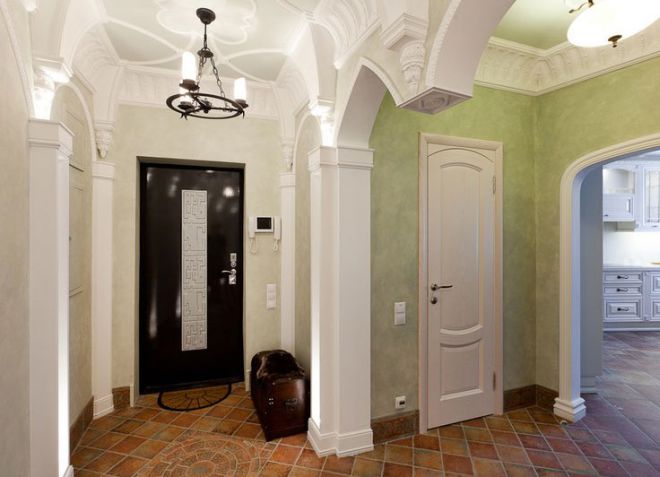
The corridor is a place where guests are met and seen off, they linger with conversations. Its environment should be comfortable and provide the necessary functionality. The original and high-quality finishing of the hallway will ensure the practicality of the room and the uniqueness of its interior. A beautifully designed corridor will emphasize the hospitality of the house, will be able to transform the whole impression of the home, create a positive atmosphere right from the doorstep.
Often people do not attach much importance to the design of the entrance premises (corridor, hallway). Wall decoration in the hallway usually consists of gluing pieces of wallpaper and painting the walls in a solid color. But any room in the house is worthy of attention. And even a corridor can become a canvas for creativity.
Before starting repairs, you need to consider the functionality of the room. Options may vary. The hallway can be used as an intermediary between rooms. If the area of the room allows, then you can place a storage system in the form of a rack, chest of drawers, cabinet. You can hang family photos, paintings or souvenirs brought from other countries on the walls. The design of the future premises depends on these answers.
To understand how to finish the walls in the hallway, you need to answer the following questions:
Finishing the hallway is carried out after the preparatory work. It is necessary to clean the walls and floor in the apartment from the old coating and plaster. All finishes include pre-leveling the surface. This type of work is best left to professionals. If the design provides for wall cladding in the corridor, then you need to lay a metal or wooden profile around the perimeter. Let's take a closer look at what materials you can decorate the walls with.
Wall panels are used specifically for lining the hallway. They are quick to install, easy to clean and cheap. There are a wide variety of color options on the market. The design can be made of slatted, tiled and sheet panels. They look like rectangular bars or squares. For the manufacture of panels, wood, chipboard, MDF, PVC, glass and plastic are used.
As shown in the photo. Often you can find a combined design: the upper part is decorated with wallpaper or painted, and panels are attached to the lower part.
Important! Finishing the hallway and corridor with panels is appropriate only in a wide room, since it takes up an additional 10 cm of space.
You can safely use panels if the design of the hallway is decorated in country style. Light wood in the wall cladding and dark floors will visually expand the space, as shown in the photo. Slatted panels with wood imitation, laid in two tiers, will create home comfort in the hallway.

In order to create a classicist style in the corridor in the apartment, it is worth decorating the walls with moldings or plaster moldings. Embossed (3D-panels) do not need an accompanying decor in the form of personal photos, mirrors, art objects. They also focus attention. This decor is suitable for lovers of minimalism and rigor.
Important! The panels can imitate any surface: masonry, “brick-like”, wooden slabs, porcelain stoneware, mosaic, fresco. It all depends on the financial capabilities of the customer.
Some twenty years ago, the design of the corridor in the apartment was made out only with paper wallpaper. Today, the market has a larger selection of materials: vinyl, non-woven, textile, liquid, cork, linkrusta, photowall-paper, quartz.
The most popular - vinyl. They are easy to clean, resistant to stress, serve for a long time, are cheap, hide surface defects. It is not difficult to choose the best option for a specific design of the hallway in the apartment. But such wallpapers have a serious drawback - they do not allow oxygen to pass through.
Advice! If photos should hang on the walls in the apartment, then it is better to choose a light background for finishing the corridor.
How to decorate the walls in the hallway of a complex configuration? You can create a unique room design with the help of liquid wallpaper. They will help to avoid joints in a room with a large number of arched openings. Wallpaper is easy to stick. There is no need for additional care.
The appearance of the coating depends on which textured finish and paint color is selected.
They contain metallic elements. They are made from porous paper. Sometimes fabric can be used as a base. A layer of thin foil is applied on top. On it, in turn, paint is applied with embossed or patterned. This elegant wallpaper looks very luxurious. In addition, they are very durable. Cleaning the surface does not take much time. The ideas for decorating the walls of the corridor and the hallway with such a coating are shown in the photo.
Important! The surface under the metallized wallpaper should absorb moisture and be perfectly flat. The glue on which they are attached will not evaporate through the canvas. Its structure is very dense.
This type of canvas has the form of a fabric base, on top of which a plastic of natural origin is applied in a thin layer. Usually the last layer is made of gel linseed oil. Wallpaper can be quickly cleaned and painted with water-based paint.
Important! Linkrust lasts a long time, but it is also expensive.
This base will withstand any impact, including pet claws and scratches. On cullets, you can easily apply paint or a pattern through a stencil. You can change the design in the corridor an infinite number of times. The surface is resistant to chemicals. With all these indicators, glass wall papers are cheaper than other modern coatings.
Decorative plaster- This is a material that is used to process walls in the corridor in any color and texture. It creates a durable, "breathable" coating, as shown in the photo. The texture of the pattern depends on the graininess of the mixture and the tool used.

In brick buildings, after cleaning the walls of old materials, you can see the original masonry. This decor can be used in the apartment. The original red brick will not fit into any interior. Therefore, it is washed, dried, and then treated with a special solution or simply painted white. Ideas for decorating a white brick hallway are shown in the photo.
Important! You can also reproduce brickwork using panels, wallpaper or ordinary paint.
In the corridor, it is advisable to take based on the size of the room, while not violating the overall style of the interior. Also, the material chosen for finishing the walls of this part of the apartment must be wear-resistant, because it will be subject to frequent cleaning.
Traditionally, some part of the population tends to wallpaper the walls in the corridor. This choice is facilitated by a large number of collections, colors, textures, and most importantly, the ability to stick wallpaper on your own, which can be either paper or vinyl. On one wall in the corridor, at the same time, you can stick photo wallpapers.
The best solution for wall decoration in the corridor will be on the lower part of the wall, while the upper one can be covered with wallpaper. Laminate, can be replaced with any other panels suitable for use on the walls in the corridor.
Plastic walls in the corridor look very modern. This finishing option will be one of the most practical for this room, since plastic is easy to clean, it does not leave stains, it is easy to install and is a fairly inexpensive material.
The stone on the wall in the corridor looks very modern and stylish, especially since modern technologies provide us with its high-quality imitation. It is not necessary to finish all the walls of the corridor with this expensive material, you can only decorate doorways with it or combine it with wallpaper, plaster. By the same principle, it is possible to issue brick walls in the corridor.
One of the traditional and proven materials suitable for laying on the walls in the corridor is ceramic tile, it is durable and practical, easily combined with other finishing materials.
One of the finishing options is painting the walls in the hallway, the only drawback of which is that the walls need to be perfectly aligned. It is best to use water-dispersion types of paints.
A fairly new, but already beloved, option for decorating walls in the corridor is decorative plaster. This type of finish coexists perfectly with other materials, for example, with stone.